INDUSTRY NEWS Flower power put to the test


INDUSTRY NEWS Flower power put to the test


HB inventors bring new meaning to sustainable growing
PRODUCT UPDATE
Let the numbers do the talking!
Ziwi veterans target Canty for $30m export pet food plant
ANIMAL ADVISOR
Off-paddock solution a game-changer in North Otago
Our new superstar, bred for the good of your animals, and the environment. Delivering high intake, yield, nitrogen uptake and persistence, this is the diploid of the future.
This hybrid ryegrass is the phenomenal 3-5 year pasture bred to deliver performance your neighbours will envy, with environmental benefits too.
The rockstar hybrid, upgraded to NEA12 endophyte. Shogun is renowned in NZ farming, setting the standard for 1-3 year pasture.
The next generation perennial ryegrass with superior persistence, improved summer growth and colour, and a great endophyte.
barenbrug.co.nz facebook.com/BarenbrugNZ





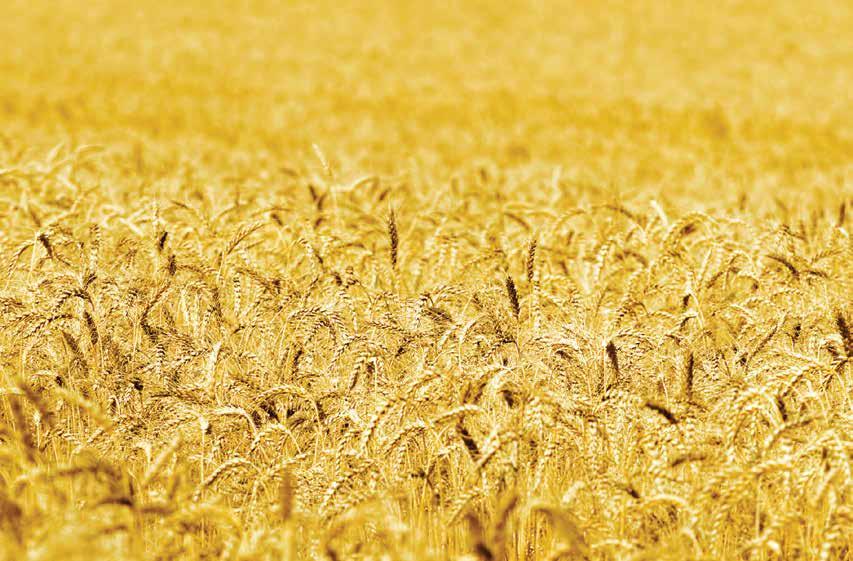
- Make sure you are up-to-date!
• Over 140 new listings
• 160 deleted products
• 100 existing labels updated (new weed, pest & disease claims)
Plus the latest regulatory amendments
The definitive guide to agrichemicals registered for use in New Zealand.
A comprehensive alphabetical listing of products, active ingredients, crop & weed tables, weed & pest identification and much, much more all in one single publication. It really is the definitive agrichemical guide and the only one you’ll ever need.
Purchase a manual to receive a FREE 12-month subscription to our subscriber only website.
The website is continually updated and contains product listings, a fully searchable online product manual, a powerful search engine of weeds, diseases & pests, including photo galleries with all the agrichemical options to use on individual crops as well as up-to-date SDS’s, Haznotes and product labels, plus posts about industry news and information.
NOW to receive your FREE pair of SureShield Coveralls

SureShield Coveralls supplied by pH7, provides both protection and comfort with exceptional liquid and particulate protection. Ideal for a wide range of industrial applications. One size fits all.
Shigematsu Respirators supplied by pH7.
* Available to those who order directly from www.novachem.co.nz - while stocks last.
Print up-to-date SDS’s & Haznotes from novachem.co.nz to ensure you are compliant.
AgriMedia Ltd, Ashcroft House Tancreds Road, R D 2. PO Box 37151, Halswell, Christchurch 8245 ph 03 329 6555 fax 03 329 6550 www.agrimedia.co.nz www.novachem.co.nz
Publishers of Rural Contractor & Large Scale Farmer, AgriBusiness, AgriVet, NZ Cropping Yearbook, Australian AG Contractor & Large Scale Farmer, NZ Novachem Agrichemical Manual.
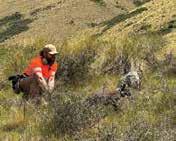
INNOVATION
© NZ AGRIBUSINESS - No part of this publication may be reproduced in any form without the prior written permission of the publisher. Opinions expressed in this publication are not necessarily that of the publisher and suggest independent advice be sought before acting on information or suggestions contained herein.
CONTRIBUTIONS
Editorial and photographic contributions are welcomed and should be sent directly to the editor, Kathy Davis. Editing of submissions is at the sole discretion of the editor and will accept no responsibility for unsolicited material.
EDITOR
Kathy Davis PO Box 37-151, Christchurch ph 03 577 5640 fax 03 577 5647
ADVERTISING MANAGER
Paula Forde mob 027 229 0362 email paula@agrimedia.co.nz
CIRCULATION
ddi 03 329 6555 email admin@agrimedia.co.nz
PRODUCTION & DESIGN
Amanda Vroombout mob 0277 788 274 email production@agrimedia.co.nz
Printed by Blueprint Ltd
INDUSTRY NEWS
Undercover agents, with a difference
4 Spy wallabies fitted with GPS collars are helping aerial hunters from Otago Regional Council discover and destroy feral populations of the fastbreeding, fast spreading pest.
Tackling a unique challenge for medcan growers
6
Medicinal cannabis is one of the fastest growing industries in the world with a forecasted value of US$46 billion by 2026.
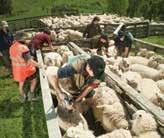
AGRIBUSINESS
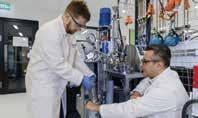
PRODUCT UPDATE
How much?! The shocking cost of drench that doesn’t work 20 At a potential starting cost of $96,390 a year, left unaddressed, drench resistance could ultimately threaten the future viability of one family’s hill country sheep and beef operation.
New weekly shipping service into Port Chalmers
28
Port Otago has welcomed back the world’s third-largest shipping service, CMA CGM, after a four-year hiatus triggered by COVID-19 interruptions and the resulting supply chain disruptions.

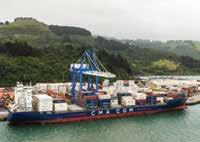
not every day an undergraduate student gets to lead their own research project, but that’s the reality for those who undertake a summer internship with Corteva Agriscience.
THERE’S BEEN A LOT OF COVERAGE RECENTLY ABOUT THE ONE YEAR ANNIVERSARY OF CYCLONE GABRIELLE, AND THE LASTING IMPACT IT’S HAD ON SO MANY IN OUR RURAL COMMUNITIES.
Such anniversaries are sobering reminders of things most of us don’t have to continue dealing with in our immediate personal or professional lives, and it’s good to be reminded of these things.
But the fact remains some people don’t need reminding, because whether it’s 365 days, or 401 days, or any time after such a catastrophic event, they’re still right in the thick of it.
So here’s to those whose daily to-do list includes adapting to and recovering from Gabrielle and all the damage she wrought, some of it irreversible, to the land, to businesses and to lives.
Here in the top of the south, drought is the current stress, and while it may have rained properly by the time Agribusiness lands on your doorstep, this has the gritty feel of a prolonged dry, with some in Marlborough comparing it to that of 2003-04.
I know there’s a bit of (justified) scepticism
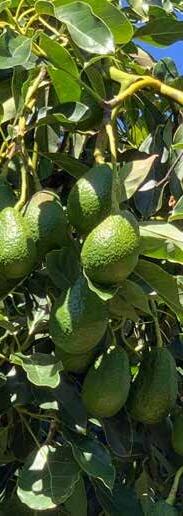
sometimes about folks crying wolf on projected weather extremes.
But as someone whose early career coincided with the severe 1988-89 South Island drought, I see all the early noise about potential trouble as a benefit rather than scaremongering.
A permanent legacy of that particular drought was the widespread recognition that being able to make and act on decisions was a make or break factor between financial disaster, and recovery.
Paralysis caused way more pain than decisiveness, even if the decisions were more like guesses at the time.
And you can’t make decisions about any potential problem unless you know it might be coming.
For now, however, take your mind off whatever the weather is doing for a while, and get stuck into some great reading in this issue.


As well as a round-up of the latest industry, product and people news, we have our annual feature on innovation for you, starting on page six.
My favourite story this time is that of Brendan and Hayley Hamilton, who have invented a genius device that babysits replacement vines and fruit trees during their early establishment, so they actually make it through to productive maturity.
It’s called H2Ortigator, and it’s not only making waves here but attracting international interest too.
Our thanks as always for your tips, suggestions and stories – keep them coming. We’ll be back in May.

Foroveraquarterofacentury, Grosafehasthrived,demonstrating ourstraightforward,practical approachtodistributorsand growerschallenges. Ouruniqueposition: leadingwithinnovative,greenerand sustainablesolutions,reflectsthe passion,prideandethosofourNew Zealandownedcompany.Webelieve ourapproachsetsusapartand strengthensourpurposeofusingour globalpartnershipsandworking togetherwithourcustomers,to supportyourlocalagriculture, horticultureandforestryneeds.
Keentoknowmore? Contactuson info@grosafe.co.nz orFreePhone:0800220002 www.grosafe.co.nz
®


ANGELICA. LICORICE. NOT THE ‘CROPS’ THAT FIRST COME TO MIND WHEN YOU THINK OF TARANAKI, AT LEAST NOT AT PRESENT.
In future, however, these medicinal and gin botanical species may help diversify the region’s land use and create new jobs.
That’s Venture Taranaki’s long-term thinking, under the auspices of its pioneering Branching Out project.
Trial plantings of all four species were sown in November in what’s thought to be a first for New Zealand because they’ve never been commercially grown here.
“This presents a great opportunity; however, it also means that there is a lot to learn for all involved,” says project manager Michelle Bauer.
“The goal is to refine the growing process to a point that, should the trials be proven to be sustainable and economically viable, our triallists and other interested landowners can proceed to commercial production armed

with a wealth of knowledge.”
The crops have been grown from direct seeding and transplants, with a minimum of three seedlines being trialled for each one, sourced from North America, Europe, Asia and New Zealand.
Weather conditions have been ideal since planting, resulting in strong establishment.
But as any farmer knows, weather that encourages sown species also helps weeds and staying on top of these has been a top priority for triallists and project agronomist Vanessa Martin.
Harvesting of calendula and angelica is due to start soon, Bauer says.
“It’s exciting to see the plants showing good growth, after a significant amount of time
URGENT WORK TO CLEAN UP CYCLONE-AFFECTED REGIONS WILL CONTINUE, THANKS TO A $63 MILLION BOOST FROM THE GOVERNMENT FOR SEDIMENT AND DEBRIS REMOVAL IN HAWKE’S BAY AND TAIR ĀWHITI.
The funding will help local councils continue urgent work removing and disposing of sediment and debris left from Cyclone Gabrielle.
Forty million dollars goes to the Hawke’s Bay Regional Council for urgent work to continue to remove sediment and debris in the region.
This includes $3 million ringfenced for woody debris removal in Wairoa.
Hawke’s Bay Regional Council chair Hinewai Ormsby describes the move as fantastic and says it will come as a relief to those still
struggling with effects of silt and debris on their land.
“With an additional $40m, the Silt Recovery Taskforce can regain momentum and work to restore more of the region’s productive land in the process.
“This will provide certainty for our local growers and producers and support the much-needed economic recovery of the region’s primary sector.”
At the end of last year just over half of the silt and debris work had been completed meaning there is still much to do.
“With this new funding we can
and research going into the initial crop selection, agronomy, commercial viability, and value-added processing opportunities.”
Branching Out is a long-term strategic project for Taranaki.
Since 2020 it has identified, investigated, and validated diversification opportunities and high-value food and fibre ventures for the region to ensure long-term sustainability and resilience of the food and fibre sector.
Crops investigated include avocado, garlic, hemp, quinoa, hops, and kiwifruit.
Venture Taranaki estimates 270,000 ha of land in the region is suitable for horticulture. Branching Out has also identified sheep milking and trees as areas of future opportunity.
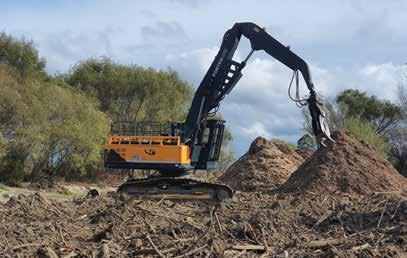
remove and dispose of around 600 thousand more cubic meters of sediment and debris, unlocking a further 650 ha of land that will be returned to viable productive uses,” Ormsby says.
In reality, the region has years of recovery work still ahead of it that simply can’t be completed all at once.
Gisborne District Mayor Rehette
Stoltz says renewed support could not have come at a better time for her region.
Contractors have already removed nearly 165,000 tonnes of woody debris and there is still a lot of work ahead.
"While this funding won't cover everything, it will go a long way in helping us to build back a stronger Tairāwhiti.”
REGIONAL COUNCIL
DISCOVER AND DESTROY FERAL POPULATIONS OF THE FAST-BREEDING, FAST SPREADING PEST.
Between December and January, one of 10 spy wallabies travelled an amazing 42 kilometres from South Canterbury to Otago and was still moving, the council says.
The ORC hunting team left this particular one on its journey as it was too close to nearby buildings to be safely pursued when they went out on their first surveillance flights last month.
But nine others were tracked, leading to destruction of 18 feral wallabies in total.
“Finding wallabies across large landscapes and difficult terrain where there are few present is labour intensive,” says ORC’s Gavin Udy.
“Any wallabies that go undetected allow small breeding populations to form and grow and become established over
time. This is why it is critical that we develop new cost-effective tools to find wallabies in these environments.”
The hunting team will be out again regularly as part of a twoyear research project conducted under approved permits from the Ministry for Primary Industries and the Animal Ethics Committee of Lincoln University, and with permission granted by landowners in Waitaki and Mackenzie districts to release the wallaby.
Gavin Udy says using spy or seeker animals as a method of pest control is common in feral goat and tahr control.
“If this technique can be used successfully for wallaby, which are moderately gregarious, it will make a significant difference to efforts to eradicate Bennett’s
IT’S TAKEN LONGER AND COST MORE THAN EXPECTED, BUT NEW ZEALAND’S FIRST LARGE NEW DAM IN 25 YEARS TICKED OFF A MAJOR MILESTONE LAST MONTH.
The reservoir behind the Waimea Community Dam, in Lee Valley southeast of Nelson, can hold 13 million cubic metres of water, and was officially declared full.
“We have been looking forward to this day for a long time and I thank the community and shareholders for their ongoing patience,” says Waimea Water CEO Mike Scott.
Now that the reservoir is full, final engineering analysis and verification of dam performance is underway, after which the dam and spillway are effectively commissioned.
The temporary pipes and facilities will then be removed to com-

wallaby from Otago and South Canterbury, particularly in areas where we have very low wallaby numbers.”
ORC is investing $110,000 over two years in field work for the research, the potential benefits of which it says will far exceed that investment in terms of protecting Otago from wallaby spread and the damage they do to native bush, farms, crops, commercial forestry, and biodiversity.
The National Wallaby Eradication Programme is contributing an additional $100,000, while Environment Canterbury is sup-
porting the research through landowner consultation, DNA sampling and supplementary control work.
Bennett's wallaby was one of five species introduced to New Zealand in the late 1800s and now occupies about 450,000 of South Canterbury land, gaining ground in North Otago.
Reported wallaby sightings have increased in the past 12 months, which ORC says is good news, because the more eyes on the ground the better to prevent the pest becoming established in the region.
plete the final hook up of the permanent pipework.
Waimea Water expects the project to be completed and commissioned this month, more than 10 years after the first resource consents were lodged.
Mike Scott says welcome summer rain helped fill the reservoir, and meant shareholders Tasman District Council and Waimea Irrigators did not need water released to fend off restrictions during January.
The dam is designed to harvest and store high flows from the Lee River during wet weather, and release this during drier months to maintain flow levels in the Lee,
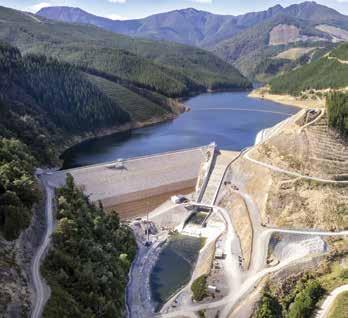
Waimea Water says this will re-
duce the risk of saltwater incursion from the coast, and improve river health as well as providing much-needed water security for the region.

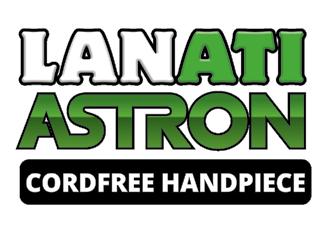



this month we look at...
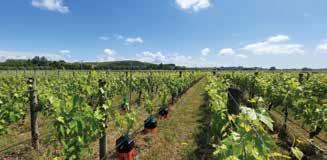

MEDICINAL CANNABIS IS ONE OF THE FASTEST GROWING INDUSTRIES IN THE WORLD WITH A FORECASTED VALUE OF US$46 BILLION BY 2026.
In New Zealand, there is potential to generate exports comparable to kiwifruit in value. But with this growth comes the challenge of managing medicinal cannabis waste, which includes unused plant matter, cultivation trimmings, discarded extraction chemicals and trashed testing samples.
There is currently no specific infrastructure available to deal with cannabis waste and most, as happens overseas, ends up in landfills.
“This adds to the more than one million tonnes of organic waste already disposed of each year in NZ landfills,” says Auckland University Associate Professor Saeid Baroutian, director of the Circular Innovations Research Centre in the Faculty of Engineering.
With NZ’s industry still getting established, there is no public data available yet on the amount of waste being produced.
Canada, where cannabis markets are more mature, is estimated to generate more than 150 million tonnes of cannabis waste a year.
Now Baroutian and fellow researchers, supported by Callaghan Innovation, are working with South Island-based producer Greenlab to find how to turn this waste into fertiliser.
The collaboration could put NZ at the global forefront of the medicinal cannabis industry’s waste management, he says.
“It’s a perfect example of bringing the circular economy to the medicinal cannabis sector. That is a big step towards true sustainability.”
For commercial medicinal cannabis operations, waste management is unique and complex, says Baroutian.
“The plant has unique qualities and, as an illegal drug outside of its medicinal use, there are strict government controls over waste handling. Cultivators must record every gram of discarded material by tagging, tracking and tracing the waste from origin to final disposal.
“This means that in addition to separating hazardous from non-hazardous waste, techniques used must render all waste beyond
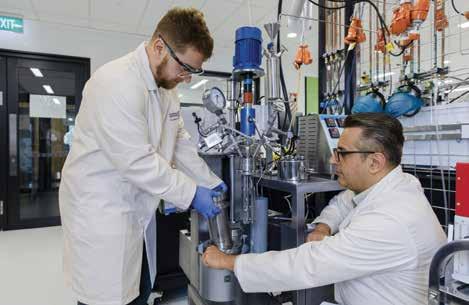
recognition and account meticulously for every scrap so producers can maintain their licence.”
The Auckland team’s process works by mixing cannabis waste with water and then heating it to high temperatures. High pressure and heat cause a chemical reaction that breaks down the waste into simpler and safer substances.
All cannabinoids such as THC and CBD, the psychoactive compounds in cannabis, are destroyed during this process.
Under high temperature and pressure, the material in cannabis plants go through a chemical transformation process that converts the wet plant waste into a dark, crumbly and dry substance that looks like charcoal. This solid product is called ‘hydrochar’ but unlike charcoal or coal, it is not harmful to the environment. It's carbon and nutrient-rich and can be added to soil to improve fertility and water retention for better cannabis plant growth.
The liquid product from the process is also rich in solubilised carbon and valuable nutrients like nitrogen, phosphorus, and potassium, which can be recovered and used as a biofertiliser to help cannabis plants grow healthier and faster.
The next step is to develop a solution for its widespread use.
Current methods for cannabis waste disposal include biological treatment (composting and anaerobic digestion, which involves breaking down the waste into simpler compounds using bacteria and other microorganisms) or incineration (burning waste at very high temperatures until it turns into ashes).
But both options have challenges.
Incineration, while effective, is prohibited in NZ under the National Environmental Standards for Air Quality due to the formation of toxic gases and particulate matter.
“Composting and anaerobic digestion of cannabis waste can only occur at an approved facility with suitable systems to control odours from the process and deal with the leachate and digestate,” explains Dr Rupinder Brar, Greenlab’s director of cultivation and resource recovery.
“Although this is an approved method of disposal, there is no scientific evidence on the fate of cannabinoids in the process.”
A COLLABORATIVE PROJECT BETWEEN DAIRYNZ, AGRESEARCH AND THE MANAWATU’S NGUTUROA CATCHMENT GROUP AIMS TO UNDERSTAND, MODEL AND MANAGE E.COLI IN RURAL WATERWAYS.
Reducing bacterial levels is a challenge in waterways in many parts of New Zealand.
This multi-year project aims to understand how E.coli gets into waterways, develop strategies to reduce losses from rural land to streams, and create a model to show how onfarm mitigations could reduce E.coli losses.
The Nguturoa catchment runs from the ranges behind Linton to the Tokomaru River and down to the Manawatu River. It comprises dairy, sheep and cattle farmers and lifestyle block owners.
Working closely with farmers, DairyNZ and AgResearch will undertake research and field work to better understand E.coli pathways and processes in farming catchments.
Project lead and AgResearch science team leader Dr Richard Muirhead is a leading NZ expert on E. coli contamination of waterways.
He says a key issue with helping farmers and regional councils manage E. coli is understanding how multiple small sources of the contaminant from farms and other land uses combine to produce the concentrations measured at swimming sites downstream.
“The long-term focus of this project enables us to develop people and capabilities in catchment E.coli modelling, to help address
this gap. We’ll collect water and sediment samples in the Nguturoa catchment, with the purpose of developing the model to represent what is happening across NZ.
“The catchment level focus is an exciting opportunity to integrate a lot of our existing farm-scale E.coli knowledge into what happens at the catchment scale, which is where water quality impacts happen,” Muirhead says.
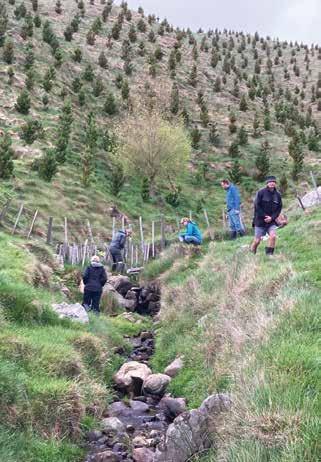
The DairyNZ team working on this project includes Craig Depree, who has nearly 25 years’ experience as a water quality scientist, and Katrina Macintosh, whose international experience spans water quality and environmental practice change on-farm.
Both have recently published research on how good farming practices have improved water quality in dairy-dominant catchments.
The sector remains committed to improving waterway health, while ensuring timeframes for implementing ongoing change are reasonable.
Continued work includes DairyNZ-led water quality research, in collaboration with other science organisations, to identify solutions for farmers at a farm and catchment level.

DairyNZ general manager sustainable dairy Dr David Burger says the new study will lead to better models for developing and demonstrating options for farmers to reduce losses and help build regulatory understanding.
“This project is part of DairyNZ’s ongoing work to support farmers to reduce their environmental footprint while continuing to run successful farming businesses. New strategies to reduce losses could be adopted by dairy farmers across NZ in areas where E.coli is an issue.”

Horizon Europe is the European Union’s key research and innovation funding programme, with a total budget of NZ$173 billion for its ninth seven-year cycle.
In 2023 New Zealand became an associated country, meaning our researchers can establish and run research projects on equal terms with European partners and receive funding.
Lincoln Agritech has joined universities and research institutions from Greece, Austria, Italy, Belgium, France, and Lithuania on a project to develop a digital system that detects and provides early warning of plant diseases.
The Agricultural University of Athens, Greece, is leading the project.
Known as STELLA, the project has a budget of NZ$9 million. It begins next month and finishes December 2027.
STELLA aims to provide the
tools to establish digital monitoring systems, combining data from multiple sources such as remote and proximal sensing and citizen science.
These tools can then be used by the EU member states and in NZ. It will focus on diseases of olive trees, plane trees, tomatoes, potatoes, grapes, and apples.
Lincoln Agritech is contributing expertise in presymptomatic sensing of fungal diseases and digital decision support.
It will also run one of the use case pilot programmes, in Hawke's Bay, monitoring spores and infections of Neofabraea alba, a fungus that causes bull’s eye rot in apples.
“While disease symptoms don’t appear until the apples are in storage, infection happens when they are still in the orchard,” said Armin Werner, Lincoln Agritech’s group manager of precision agriculture.
“Fruit developing the brown lesions becomes unmarketable, so knowing if and when they become infected is key.”
The project aims to assess the risk of infection for fruit still in the orchard and develop and test a model that reveals that risk. By involving end-users in codesign, the project aims to make the system easy to use for nonexperts and training, ensuring it is widely adopted.
In NZ the project will collaborate with the industry-led Sustainable Food and Fibre Futures project ‘Smart & Sustainable’. This is managed by NZ Apple & Pears and is now in its second of seven years.
In Europe, the project will study grapevine leafroll associated with virus disease (which is also a significant problem in NZ) and two other diseases that are present but not significant problems here (grapevine bois noir and

potato leafroll virus).
It will also look at several crop diseases that NZ’s strict biosecurity has so far kept out, but any tools developed would be useful to NZ should there they occur here.
The ability to join European colleagues on Horizon Europe projects is a welcome step for NZ researchers working on global problems, Armin Werner says.
“Plant diseases cost the global economy more than NZ$360 billion a year.
“To develop a system that can accept data from multiple sources and detect outbreaks before they become unmanageable will help hugely in global food security.
“Being involved in this and other EU projects with leading European scientists creates synergies that will support NZ’s research and development capabilities and success.”

WITH THREE DIFFERENT WATER SYSTEMS ACROSS 712 HA OF HILL COUNTRY
RISING TOWARDS 600 METRES IN THE TARARUA DISTRICT, ALEX AND ROB FOREMAN NEEDED A WAY TO ENSURE THEIR LIVESTOCK ALWAYS HAVE WATER.
They turned to Gallagher’s Satellite Water Monitoring system. This secure and reliable ‘eye in the sky’ gives them peace of mind 24 hours a day that their tanks, each containing 20,000 litres of water, are always full.
The Foremans have been running Ruatea Trust in Alfredton, Tararua since 2016. They farm 3600 Romney ewes, 1400 hoggets and rear 150 Friesian bulls each year, growing them from four-day-old calves and finishing them at 500 kg.
“We've got three different water systems. Some are gravity fed; some are pump fed. The nature of the property means they are not all in line of sight or in cell phone range,” says Rob Foreman.
“With just Alex and me running the property, we needed an efficient way to keep an eye on our water and make sure our livestock always have what they need, without having to cover hundreds of kilometres to check the tanks all the time.”
Gallagher’s Satellite Water Monitoring System uses a low-power, secure satellite connection to capture water tank level information and sends it to farmers’ phones via text or email alerts.
For the Foremans, it was the perfect solution. “It’s awesome! It was so easy to set up and we get readings sent to our phones during the day as the satellite passes over us. It gives us peace of mind our tanks are always full,” says Rob Foreman.
He has set up the Satellite Water Monitoring System to send alerts when the tanks fall below 75 per cent full or 50 per cent full.
“It sends me a notification and gives me an idea of how fast the water is dropping so I can see if there’s a leak and get on to it straight away.”
Friesian bulls drink much more water than sheep, and ‘wreck stuff’ when they don’t have access to what they want, he points out.
“It’s real peace of mind knowing I can check my phone while I’m having a cup of tea and know water is getting where it needs to be.”
The system saves valuable time in summer, when the pair don’t have time to physically check each tank.
And they’re impressed with its robustness.
“Most of our tanks are in high areas and the system handles the sun and windy conditions no worries,” he says.
“We've also had snow on them, which has
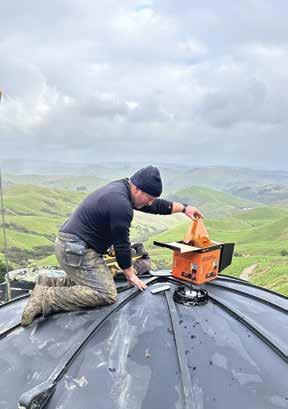
not affected its performance whatsoever. At first, I was a bit worried about the receiver poking up on top of the tank, but it’s absolutely not an issue.”
The Satellite Water Monitoring System has already saved Rob Foreman one headache when a blocked line stopped water going into the tank.
“I could see the water level dropping throughout the day on my phone and we knew there was an issue so I could get to it and fix it quickly,” says Rob.
“The system gives us a better view of our water and reassurance our stock always have enough. It saves us time, but also helps us manage what is an extremely precious resource.”
WHAT’S THOUGHT TO BE THE WORLD’S FIRST LIPSTICK ENRICHED AND TINTED WITH WOOL KERATIN PIGMENT HAS EARNED THE KISS OF MARKET APPROVAL SINCE ITS LAUNCH 18 MONTHS AGO.
Kera Kisses, an unexpected new avenue for strong wool created by New Zealand-based Wool Source and leading global beauty entrepreneur Karen Murrell, is bringing buyers back for more.
“The lovely thing about Kerra Kisses is that our customers often comment once they have tried this lipstick they won’t use anything else!
“The hydration content of this shade is an extra bonus," Murrell says.
The ultra-fine wool keratin pigment powder developed by Wool Source is a drop-in ingredient for the lipstick.
Murrell says it’s undetectable in
application, very soft, completely non gritty, and applies like a very smooth, balm-like lipstick with a deep red colour.
Hailing from a rural background in Te Awamutu, and keen to support the farming sector, she was particularly excited to see the initial concept come through testing so well.
Wool used for the pigment is from Westmere Farm in Ashburton.
“The traceability of the keratin held huge appeal for us and the design on the product box is a shot of the actual farm that the sheep are from,” she says.
The wool keratin powder can
absorb and neutralise pollutants, preventing them from damaging skin via oxidative stress.
The absorbent nature of the keratin powder in the pigment and its light sponge-like character locks the moisture in close to the skin, keeping the lips well hydrated.
Wool Source pigments are one of the products Wool Source is looking to commercialise out of the New Uses for Strong Wool programme backed by wool growers, supply chain participants, Ministry for Business and Innovation and Employment and the Ministry for Primary Industries’ Sustainable Food and Fibre
Futures fund.
The seven-year multi-milliondollar research programme was spearheaded by Wool Research of New Zealand (WRONZ).
WRONZ then founded Wool Source in 2021 to test market potential for its world-leading technology in deconstructing wool fibre into pigments, powders and particles that retain wool’s performance benefits at ultrafine particle level.
Kera Kisses is the first product to be created and commercially available using Wool Source’s drop-in ingredient and is believed to be a world-first in beauty.
GETTING RID OF ONE TYPE OF TREE HELPED MOTIVATE DANIEL SCHWEIZER INTO FOUNDING HIS OWN DRONE SPRAYING BUSINESS, BUT THE TECHNOLOGY ALSO GIVES FARMERS A PRECISE, COST-EFFECTIVE WAY TO LIFT THE POPULATION OF OTHER, MUCH MORE DESIRABLE TREE SPECIES, HE SAYS.
Agridroneco in Bay of Plenty began in 2020.
Its main focus is utilising large spray drones for crop spraying, weed control, seed spreading and high-resolution farm contour maps.
Schweizer grew up on a South Waikato dairy farm, and did a B.ComAg at Lincoln University before working throughout the South Island on dairy and sheep farms, and beekeeping.
“While beekeeping in Central Otago I saw first hand the impact of wilding pines and the need for a solution other than the laborious task of manually spraying them, especially on steep hillsides.
“It was around the same time I saw the first 10 litre spray drones on YouTube, and I instantly recognised their potential here in New Zealand for spot spraying weeds.”
Gaining his Part 102 advanced drone pilot certification during COVID-19 was "a bit of a process” but he persevered, and
was eventually able to buy a 30 litre DJI spray/spreader drone to launch Agridroneco.
Weed eradication remains a key service, but he’s also excited about what he says is the technology’s ability to supercharge native vegetation and biodiversity.
Native tree planting initiatives on farms across NZ have made substantial progress in restoring ecosystems.
“However, these efforts can take time to yield substantial results due to factors like uneven planting and variable seedling growth. This is where drones come into play.
“Drones are capable of dispersing native tree seeds with unparalleled precision. By dropping seeds directly onto previously planted areas, they can help ‘bulk out’ existing tree plantations. This means more trees, more diversity, and faster growth, bringing farmers’ restoration projects closer to their goals.”
“We’re excited that the first product using our ingredient is on the market in NZ and will be something New Zealanders and growers can get behind,” says Wool Source chief executive Tom Hooper.
“By collaborating with an experienced and respected brand like Karen Murrell, we’ve been able to test the performance of our pigment with a rigorous product development process and we’re delighted it’s created a product that Karen and her team are excited by and keen to promote.”
Wool Source is receiving a lot of interest in its products form different sectors and organisations around the world, Hooper adds.
“We have ingredients that are natural, sustainable, ethically sourced, biodegradable and completely traceable and that’s increasingly important to brands and to consumers.
“And then wool brings all these amazing performance benefits like moisture management, pollution control, odour absorption, flame retardance and more.”
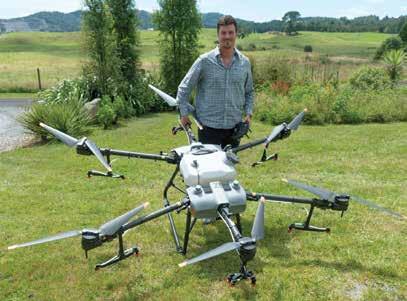
Denser plantings have another inherent benefit, Schweizer points out.
Weeds are a common challenge in reforestation projects. They compete with native trees for resources and can hamper their growth.
Hand-weeding can be labourintensive and time-consuming. Drones offer a more efficient solution.
“When drones distribute native tree seeds, they also serve as agents of weed suppression.
“Native tree seedlings, once established, can outcompete invasive weeds for sunlight, water, and nutrients.”
This natural competition reduces the need for manual weeding and herbicides, making tree plantations more sustainable and cost-effective, he says.
Farmers who have retired land for conservation can use drones as an alternative to labour- intensive planting and weed control, making services such as Agridroneco highly cost effective for
Drones can disperse native tree seeds with unparalleled precision, Daniel Schweizer says�
ecological restoration and maintenance.
“And environmentalists will be pleased to know this technology offers several eco-friendly advantages. Drones have a smaller carbon footprint compared to traditional machinery, and their precise seed distribution minimizes disturbances to the surrounding environment, preserving fragile ecosystems while promoting biodiversity.”
In short, Schweizer says, drones are revolutionising ecological restoration on NZ land.
“For farmers, this means costeffective conservation efforts that can be sustained over time.”
For environmentalists, drones are a powerful tool for protecting native ecosystems and promoting biodiversity.
“Together, we can harness the potential of this innovative technology to create a greener, more vibrant future for NZ’s landscapes, benefitting us all.”
For more detail visit agridroneco.co.nz or phone 022 352 6708.

HIGH VALUE YOUNG GRAPEVINES AND FRUIT TREES ARE BEING BABIED INTO HEALTHIER, MORE PRODUCTIVE LIVES THANKS TO A CLEVER DEVICE THAT SAVES WATER AND OTHER RESOURCES WHILE GETTING THEM UP TO COMMERCIAL SPEED AT LEAST A YEAR FASTER.
Now the technology is spreading from its birthplace of Hawke’s Bay to Marlborough, Nelson, Otago and Pukekohe with plans to further deploy units into California in time for the Northern Hemisphere growing season.
H2Ortigator is the brainchild of husband and wife team Brendan and Hayley Hamilton, who describe its mix of precision irrigation and nutrients as the perfect hands-free babysitter for new replacement plantings in vineyards and orchards.
Many of these fail when left to fend for themselves and cause significant losses in the process, something Brendan Hamilton witnessed frequently in his previous career as a horticultural consultant.
“I was seeing across the board young trees dying at a rapid rate. Those that survived were only producing about 65 per cent of their actual capacity, so I saw a big opportunity to solve a problem there,” he says.
A key challenge? Replacement trees and vines need to be cared for differently than mature ones. Growers want to restrict growth of mature plants so that energy
is directed towards fruit production, while simultaneously encouraging vigorous growth in young replacements. This in turn necessitates more frequent watering and specific nutrition,
In searching for a way to balance these competing goals, the Hamiltons started in their own backyard with native trees, and developed the idea from there, eventually moving into commercial horticulture.
“What surprised us was the size of this problem not just in New Zealand but globally. There is a one to five per cent replacement rate for trees in high-value horticulture but that equates to $203 billion a year globally in lost production,” Brendan Hamilton says.
H2Ortigator units are easily integrated into existing irrigation systems.
When fitted around the base of young plants they not only automatically take care of water and nutrition, but also give critical shade, and protect them from pests, machinery and crop protection sprays with very little staff involvement.
Mobile and completely reus-
H2Ortigator delivers water precisely where it’s needed, reducing waste and maximising plant health�

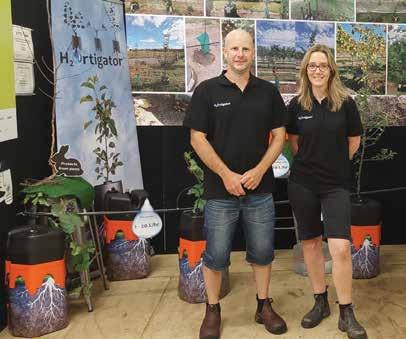
able, H2Ortigator can be used over and over again.
The patented self-cleaning system allows the unit to operate long-term in the field without the need for maintenance.
In vineyards, it’s been shown to increase survival rates and early growth of vines, reduce stalling and stunting and lead to earlier fruit bearing and returns. It also saves about 60 per cent of water per vine, the Hamiltons say.
And its success lies both in functionality and necessity, because current practices of manually caring for replacement plants are unsustainable in the long term.
H2Ortigator has turned heads in the industry already, earning such accolades as the Hawke’s Bay Fruitgrowers Fourneux Trophy for Innovation in Fruit Growing and the Irrigation NZ Innovation in Irrigation Award.
These awards validate the significant impact of the product on plant growth and water savings, Brendan Hamilton says.
Sustainability both in outcome and design is a big driver for the business.
“We want to be reducing water use but getting the same gains and ensuring we are using recycled materials where possible while creating a product that will last the test of time. We don’t want to be adding waste into horticultural and viticultural systems.”
Some of their biggest challenges came early. Designing a product that can fit a variety of different trees, vines and grow-
ing systems is complicated and took time to refine.
“We’ve designed it to cover a range of crops from apples, kiwifruit, right through to tree nuts, so developing something that fitted with the machinery and different setups was challenging.”
One of their biggest ah-ha moments in initial development is thanks to one of their children.
During the testing and trial phase, they were encountering issues with contamination and clogging in the emitters.
“I was manually blowing air into them to unclog them, then one of our children came up and said why don’t you just pump air into it? The lightbulb went off and what we were able to do after allowed our product to stay in the field long term without any maintenance.”
Looking back, they said they would’ve gone bigger, and faster with every stage, in particular the prototype trials.
“We would’ve done trials over more crops with more units to get a larger overview of our product fit which in turn would’ve sped up our market entry,” said Hayley Hamilton.
Like all entrepreneurs, a big part of their journey has been navigating the emotional side of business development.
“To anyone with an idea, don’t muck around. Just do it. So many great ideas never get past the thought stage.”
H2Ortigator has been supported by Callaghan Innovation and Sprout Agritech.
IT’S TAKEN FOUR YEARS, NINE PROTOTYPES AND A LOT OF HARD WORK AND INVESTMENT, BUT THE NEW LANATI ASTRON SLIMLINE, HIGH TORQUE CORDFREE HANDPIECE IS NOW FLOWING OFF THE PRODUCTION LINE.
Designed and supplied by Rurtec, the unique slimline de-
sign can be enjoyed by all and is particularly easier for those with
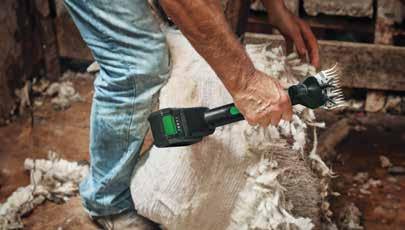
small hands or arthritis or other hand afflictions to get their mitt around.
The brushless, slotless 18 V motor produces torque that makes shearing speed more comparable to that achieved on the board.
It will power a wide/concave comb through the fleece with ease leaving the current cordless options in the dust.
The use of a trilateral metal drive cog system and motor trip for safety and to prevent machine damage are both advances on the available cordless technology.
A NEW ZEALAND/IRELAND JOINT RESEARCH PROGRAMME STARTING THIS MONTH AIMS TO BETTER UNDERSTAND METHANE EMISSIONS FROM PASTURE-BASED FARM SYSTEMS.
The four-year programme will see researchers, students, professors and database technology experts from DairyNZ and Ireland’s Agriculture and Food Development Authority (Teagasc), University College Cork and Irish Cattle Breeding Federation working together to quantify methane emissions from dairy cows in pasture-based systems.
DairyNZ principal scientist Jane Kay says they aim to determine the effect stage of lactation and pasture species, management and seasonal growth have on base methane emissions, and how these factors influence cows’ response to methane-reducing technologies.
“The joint programme strengthens our connection with Ireland and enables NZ to leverage current and future research. It also fits within DairyNZ’s wider research programme.
“This wider programme sees our world-leading scientists working with NZ farmers, research organisations and commercial companies to develop workable and scalable mitigation solutions that can be widely adopted on-farm to reduce emissions in a sustainable and viable way.”
The programme will also develop a methane database for pasture-based systems to ensure emissions and mitigations are accurately accounted for at a farm and national level in NZ and Ireland. Both countries face national and market targets to reduce methane.
Kiwi farmers are among the world’s most emissions-efficient. Consumer and dairy supplier expectations are a driver for dairy farmers to continue reducing emissions, so NZ can remain competitive in the market. DairyNZ’s continued research sup-
The first comment from most who pick up the LANATI ASTRON Handpiece for the first time is how light it is, Ian Carr from Rurtec says.
“It is a similar weight to a machine driven handpiece, even with the battery included.”
The Astron handpiece comes with a three year warranty.
Like the existing LANATI products, the ASTRON handpiece should be returned to Rurtec for any servicing. Rurtec also sharpens combs and cutters and clipper blades.
“Rurtec is excited to be launching the LANATI ASTRON handpiece to New Zealand and the world.
“We believe it is the world’s best cordless handpiece and the international interest to date certainly supports that.”
The original gold LANATI Handpiece and red clipper will continue to be available.
For more details call 0800 RURTEC or visit rurtec.com.
tunities or barriers for adoption of these solutions into NZ farm systems. “
ports that.
Over the past 20 years, potential technologies to reduce methane emissions have emerged from all over the world.
DairyNZ is focused on potential technologies that fit within NZ’s pasture-based systems, such as early life intervention, which involves feeding a natural product to young calves, with the aim of reducing methane emissions for the animal’s lifetime.
“This is an attractive delivery mechanism for NZ, as it’s costeffective and occurs well before product processing, such as milk harvesting,” Jane Kay says.
Most of the research on methane mitigation technologies is completed at Lye Farm, one of DairyNZ’s two Waikato research farms.
Farmers are involved in all the projects, to provide their thoughts and advice on oppor-
We’re excited about our continued work alongside farmers and other sector and research organisations to develop mitigation solutions for our unique pasture-based farm systems – and to get ahead of the environmental challenges farmers face,” Jane Kaysays.
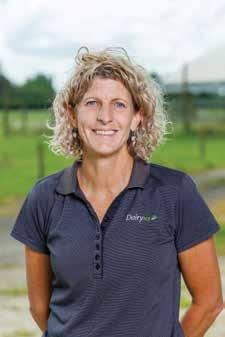
DairyNZ principal scientist Jane Kay�

OVERCOMING A FORMERLY SEEMINGLY IMPASSABLE DIVIDE BETWEEN EFFICACY AND SUSTAINABILITY, IRONMAX PRO SLUG AND SNAIL BAIT FROM UPL NZ LTD DELIVERS BOTH.
Pieter Van Der Westhuizen, UPL NZ regional manager upper North Island says manufacturer De Sangosse took their top performing Metarex Inov slug bait and made it environmentally friendly.
“You could say it’s been ‘betterised’.”
He says as result, Ironmax Pro treads very gently on the earth without losing anything in terms of potency.
“That’s a significant achievement. It’s BioGro certified and offers the best of both worlds.”
IPM-friendly, Ironmax Pro is proven to have limited impact on beneficials including earthworms, and the slug predator carabid beetle.
It’s also safer around stock, companion animals, and farm dogs, and more pleasant to work with, thanks to reduced odour.
Van Der Westhuizen is quick to add, however, that the baby hasn’t been thrown out with the bathwater.
“Metarex Inov still has a lot of dedicated advocates. Ironmax Pro is another string to the slugprotection bow, providing an equably viable option for those who choose a sustainable path.”
He says uptake of Ironmax Pro has been strong, particularly in the Waikato.
“The feedback has been positive. People have called to say they’ve seen almost instant results.
“Some of the prominent rural contractors and farmers got on board and then the floodgates opened. It’s been really well received.”
Van Der Westhuizen says this was during a very challenging season for the region, with elevated slug pressure due to intermittent rain and high humidity.
Ironmax Pro is manufactured using a unique wet process, which makes it very rainfast, which he says was perfect for the Waikato but would work equally well elsewhere.
The De Sangosse sustainability credentials run deep.
The high tech De Sangosse factory in France uses up to 33 per cent green electricity, and achieves a 50 per cent energy saving on lighting by using natural light and LEDs.
It is also completely dust free. What is even more remarkable is the fact that the whole factory is run by only nine staff.

"De Sangosse definitely walks the talk,” Van Der Westhuizen says.
“Ironmax Pro even comes in a double lined paper bag which is practical and better for the environment.”
That commitment to the future of the planet is backed by hard science.
Ironmax Pro uses Colzactive technology developed from specially selected oil seed rape molecules.
Twenty plant species were initially evaluated by scientists and 50 potential molecules identified based on their appeal to slugs.

AgResearch scientist Dr Mike Cripps�
The price of failure – slug damage in new pasture�
Two extraordinarily attractive and palatable molecules were selected in the end.
These facilitate rapid detection by slugs and enhance Ironmax Pro’s taste and how quickly Ironmax Pro works compared to other baits.
The research showed slugs actually actively prefer feeding on Ironmax Pro to feeding on seedlings.
Van Der Westhuizen adds that it’s a myth that juveniles won’t ingest on the bait. “All slugs and snails can, and will, feed on it!”
For more information contact UPL at upl-ltd.com/nz.
THE CLIMATE IS THE SOURCE OF MUCH OF HUMANITY’S CURRENT CONCERNS, BUT IT CANNOT BE BLAMED FOR LACKLUSTRE PERFORMANCE OF A THISTLE-MUNCHING BEETLE INTRODUCED TO NEW ZEALAND, RESEARCHERS HAVE FOUND.
AgResearch scientists set out to find a reason for ‘sporadic im-
pact’ of the leaf-feeding tortoise beetle (Cassida rubiginosa),
RYEGRASS ENDOPHYTES. SO SMALL, SO POWERFUL, AND SO COMPLEX. DO WE REALLY NEED ANOTHER ONE THIS SEASON?
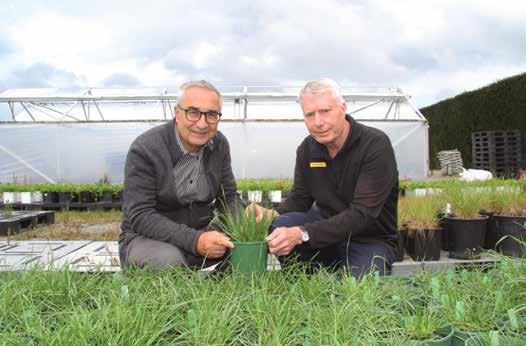
Life would be simpler with fewer endophytes, for sure. But here’s the catch – in this case, your farmers would miss out on a striking gain in pasture performance.
It’s all to do with how different endophytes bond with different ryegrasses. Some form dream teams. Some do not. The only way to find star partnerships is to have multiple endophytes to choose from.
Super-charged
Take Shogun hybrid ryegrass, for example. Newly paired up with NEA12 endophyte, it grows 8 per cent more feed than it did with its original endophyte. Given plant breeding delivers about 1 per cent gain a year, that’s
Barenbrug science manager Colin Eady, left and commercial manager Graham Kerr�
Barenbrug science manager Colin Eady says the reason for this lies in endophyte’s ancient history.
Millions of years ago fungal grass parasites lost their ability to spread from host to host and became trapped within (endo) the plant (phyte).
As time passed, endophytes began forming specific relationships with different grass genetics in different parts of the world.
Because endophytes are asexual, they cannot evolve the way ryegrass can, so those relationships became fixed and stable as long as the grass host did not need to change quickly.
Mix it up
Modern plant breeding, however, is all about quick change, mixing up a wide range of ryegrass genetics to create better pastures.
“For example you might have an endophyte from the Mediterranean that existed for millions of years in diploid perennial ryegrass, and suddenly you put it into a perennial X annual ryegrass hybrid that has been tetraploided!
“That hybrid is very different from its ancestors. Yet we’re expecting the endophyte to work well in this new ryegrass. So it’s not surprising that it takes time and a lot of empirical testing to find a good marriage.”
eight years of progress in one go!
“We couldn’t have made this happen without first discovering NEA12 endophyte, and then testing it in Shogun,” explains Barenbrug commercial manager Graham Kerr.
“The more we research endophytes, the more we learn that the marriage between endophytes and their host ryegrass is as important as each is individually.
“We’re not trying to make anyone’s lives complicated by releasing new endophytes!
“But creating the best possible pastures increasingly requires great endophyte/ ryegrass partnerships. And you can’t achieve these using just one endophyte.”
In developing a family of endophytes, Barenbrug has given itself greater opportunity to produce the best pastures for farmers, Eady says.
“It gives us a greater range of ryegrass and endophyte germplasm that we can use in our breeding programme.”
The company has screened over 400 different endophytes from different families since starting endophyte research 35 years ago.
It’s slow, painstaking work, but as the results of pairing up NEA12 with Shogun demonstrate, it’s definitely worth the wait, Kerr says.
For more detail, talk to your local Barenbrug area manager.
which was introduced to NZ from Europe in 2007 to help control Californian thistle.
This weed costs NZ agriculture millions of dollars a year.
The beetle is now widespread here, but its impact is not.
“One hypothesis was that the variation in the climate around NZ might explain the fact the beetle has not flourished and been as successful in its transplanted home as we might have
hoped,” says AgResearch principal scientist Graeme Bourdôt.
The scientists developed a climate-niche model for both Californian thistle and the beetle using the CLIMEX modelling software.
A limited amount of field observational data on the beetle’s impact on the thistle in NZ was available and was drawn on.
In the research published earlier this month with Cervantes Agr-
itech and the Australian National University, Bourdôt and colleagues found no evidence that a climate benefit to the thistle vs the beetle explained the beetle’s performance.
“There are other hypothetical explanations for the variable performance of the beetle, including the lack of suitable habitat and insulation for the beetle to make it through the winter season; other animals such as
spiders preying on the beetle so that there are less to feed on the thistle, and thistle control programmes that are incompatible with the beetle and the role it plays.
“What this research reinforces is that while climate suitability is important for the success of a biological weed control programme like the thistle-eating beetle, other factors also play an important role.”

WORDS: Nufarm
SOMETIMES NUMBERS TELL A FAR MORE COMPELLING STORY THAN WORDS, ESPECIALLY IF THEY RELATE DIRECTLY TO YOUR CLIENTS’ OWN INDIVIDUAL FARM PRODUCTION.
So if you want to add extra persuasion to your discussions with farmers about pasture weed control this season, hop online at grassmanship.nz and say hello to our new Grassmanship app.
It includes online calculators and resources to help maximise farmers’ returns from every hectare of their land.
The calculators are free; you can personalise them to your farmers’ paddocks and production, and we guarantee they will help quantify exactly what those farmers stand to gain or lose by making certain spending decisions about herbicide inputs in the weeks and months ahead.
We’ve made the Grassmanship programme to support rural professionals as well as end users, because we know field reps, agronomists and advisors play an important role in shaping farmers’ decisions about spending priorities in tight times.
We also know weed management programmes are sometimes one budget line item perceived as non-essential, despite their relatively modest cost and significant impact on on-going productivity and feed quality.
The truth is, investing in controlling pasture weeds, particularly in newly sown pasture, pays a return within six to 12 months in a
range of situations.
That’s why we’ve loaded Grassmanship with no fewer than seven different calculators – each with North and South Island options – to cover the most common pasture weed control use-cases on farms across New Zealand.
As well as spring weeds for dairy farms, you’ll also find both winter weeds and new pasture for dairy, beef and sheep.
Farmers intuitively know old run out pastures don’t produce as much feed as newer, higher performing pastures, just like they know maintenance fertiliser supports higher annual feed production, and improved animal genetics benefit their business.
But they don’t always know exactly how their own bottom line would be affected by the loss of pasture yield, quality and utilisation if weeds were left unchecked.
The calculators allow both you and them to compare and contrast the outcome of different weed control scenarios in terms of net return on investment per hectare.
Clean, productive pastures, year-round, power NZ farming and offer a double win, because they give both higher dry matter yield, and better feed quality, than those which are infested with weeds.
That sets up on-going systemic benefits,
not least being easier grazing management, happier animals and more milk, weight gain and/or meat.
As well as the calculators, grassmanship. nz also provides useful information to help you and your clients get great results from a pasture protection programme, including a range of Nufarm’s resources that support best practice.
Full details on all our Grassmanship products, including the likes of Baton 800WSG, Dictate 480, Thistrol Plus, Valdo 800WG, Tribal Gold, Sprinter 700DS and Bonza Gold plus several more, are one click away from this app.
We have also built a resource library featuring our most popular downloads and tech sheets on looking after pasture all year.
Much of the background data for the calculators is built from commonly referred to industry statistics and regional pasture growth data generated by Beef+Lamb NZ and DairyNZ.
As always, we emphasise good agricultural practice as the foundation for success – using the right products at the right rates and at the right time. Spraying weeds earlier, rather than later often yields the best results.
For more detail, contact your local Nufarm territory manager.
AUSTRALIAN CLIMATE TECHNOLOGY COMPANY RUMIN8 HAS OFFICIALLY OPENED ITS MANUFACTURING DEMONSTRATION PLANT, A SIGNIFICANT MILESTONE ON ITS PATHWAY TOWARDS COMMERCIALISATION OF ITS AFFORDABLE FEED AND WATER SUPPLEMENTS THAT REDUCE METHANE EMISSIONS FROM LIVESTOCK.
Located in Perth and officially opened by Western Australia Agriculture Minister Jackie Jarvis, the new plant has been built to provide proof of concept – technical, manufacturing and cost of production – to produce the various formulations of Rumin8’s inaugural product.
“The demonstration plant will help Rumin8 overcome one of the biggest hurdles to commercialisation,” says Rumin8 CEO David
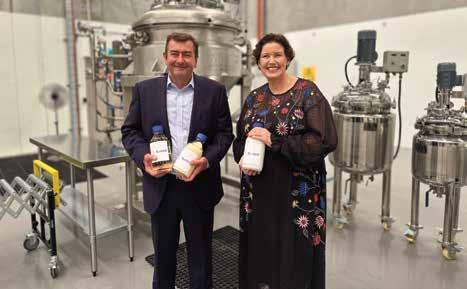
Messina.
“We know our product works in terms of reducing methane emission from livestock while retaining or improving productivity.
“Now we need to refine the production of our formulations in a pharmaceutical manufacturing setting rather than a laboratory setting to demonstrate a range of outputs such as cost, product integrity, and quality asssurance.
“We have every confidence we can successfully achieve those goals using this demonstration plant.”
The plant is a precursor to large scale production, including pilot plants and full-scale commercial operations.
Once operating at maximum design capacity, it is expected to produce thousands of doses a day, providing additives to support large-scale trials of Rumin8’s product.
AQUALINC HAS TEAMED UP WITH SCADAFARM TO OFFER NEW ZEALAND IRRIGATORS A SOPHISTICATED AND COMPREHENSIVE SYSTEM TO BETTER MANAGE WATER USE AND CONSENT COMPLIANCE.
Aqualinc general manager Jim Herbison says the result will have major advantages for irrigators and other water users, giving clients access to the knowledge, expertise and services of two major players in NZ irrigation management.
“For 20 years Aqualinc has worked on land and water resource management, research, and irrigation design and development in NZ,” Herbison says.
“Part of our service has been our ‘MyIrrigation’ platform, which customers used to make
irrigation decisions and track water use for compliance.
“However, that platform in its current form is at the end of its useful life.”
In response, he says, Aqualinc has taken the opportunity to collaborate with SCADAfarm to offer existing and new clients a considerably improved water management, analysis and compliance cloud-based system that can be monitored, via a cell phone or laptop, from anywhere in the world.
The new system will see field
“In addition to our own staff, we have established partnerships with local laboratories at University of Western Australia and Murdoch University to supplement on-site operations for testing and validating our product,” David Messina says.
Rumin8 identifies naturally occurring compounds that have anti-methanogenic properties.
Instead of harvesting and extracting them from plants, however, it is able to reproduce them in a highly efficient, low cost, scalable, and high-quality process to feed to livestock in order to reduce their emissions.
Backed by the Bill Gates-founded Breakthrough Energy Ventures Fund, the company began trials integrating its products into New Zealand pasture-based systems last year, working with DairyNZ on dairy cows, and AgResearch on beef cattle.
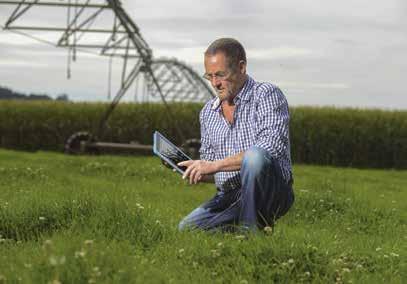
data from Aqualinc customer systems seamlessly uploaded into the MyIrrigation/SCADAfarm platform.
Herbison says the partnership is an exciting new opportunity for SCADAfarm/Aqualinc.
Both organisations focus on supporting customers with the latest tools and technology to help them navigate through in-
creasing scrutiny on irrigation water use.
This includes evaluation of equipment efficiency.
“Customers will be able to graphically view all their sensor data equally well on phone or PC. Because it is web-based, access is very slick; there are no passwords to forget, and navigation is simple and intuitive.”
WORDS: RAGT
THINK BACK TO 2006. JUSTIN TIMBERLAKE WAS BRINGING SEXY BACK. FACEBOOK WAS JUST BECOMING A THING. THE WORLD SAID ‘FAREWELL COBBER’ TO THE CROCODILE HUNTER. AND THE RAGT NOVEL ENDOPHYTE JOURNEY WAS JUST GETTING STARTED.
Today it’s finally commercially available to farmers with RGT18 novel endophyte combined with Hustle perennial ryegrass.
As part of New Zealand Plant Breeding and Research Association, RGT18 went through a range of protocols for testing, a multiyear process that included agronomic, insect, and animal safety trials.
It’s an essential process in order for a new endophyte to be recognised by the industry.
In the most recent National Forage Variety Trials tables, Hustle RGT18 came in as a top tier player, reinforcing the significant investment in not only novel endophyte but in the genetic development that RAGT has made. Why is choosing a good endophyte important?
It’s all about a ryegrass plant’s ability to persist and grow in the face of pressures such as insect attack.
Take perennial ryegrass for instance.
It’s the main pasture species used in NZ, but increasingly it’s challenged by black beetles, and Argentine stem weevil.
That’s why perennial ryegrasses should be combined with novel endophyte.
Endophyte is a type of fungus that lives naturally in the plant (found in the seed, and base of
the plant as it germinates and grows) and produces chemicals (alkaloids) that can ward off insects.
Some alkaloids the endophyte produces can be bad for animal performance, though, which is why seed companies develop ‘novel endophytes,’ selecting strains of the known chemical compounds with the aim being a higher proportion of the good ones that protect against pests and help improve persistence, and no or limited amounts of the bad ones that impact animals.
Farmers and reps should select the endophyte they need based on what pest profile they have onfarm.
Hustle has already proven itself as one of NZ’s top performing perennial ryegrasses.
Now with RGT18 endophyte, it’s got even better pest protection and the ability to be utilised in more environments.
RGT18’s stronger pest protection im-
Herbison says a vital part of the new system is forwarding of compliance data, including flowrates and levels, to local regional councils where required.
Council data must be continuous and delivered reliably.
“SCADAfarm is a well-proven platform with a solid reputation with regional councils throughout the country. Combined with our experience in resource management this places us in a unique position to offer clients the best information and systems to ensure they maximise efficiencies and production
proves productivity and persistence.
“Our novel endophyte programme has been a significant investment by RAGT, which has taken close to the duration that we have operated in New Zealand,” says RAGT NZ’s commercial manager James White.
“But it’s a crucially technology
for us and we are very pleased to commercially release RGT18.
“This technology will be equally important for farmers, who are facing ever-increasing pressures economically, environmentally and socially.
“At RAGT NZ, it’s our mission to be the partner of the agricultural world to create innovative solutions for the challenges of today and tomorrow.
“Being part of one of the world’s leading seed groups, we’re able to offer farmers comprehensive seed technology advancements that are the result of world-leading R&D and extensive local trials and testing.
The RGT18 endophyte is proof of this.”
For more detail visit ragt.nz.
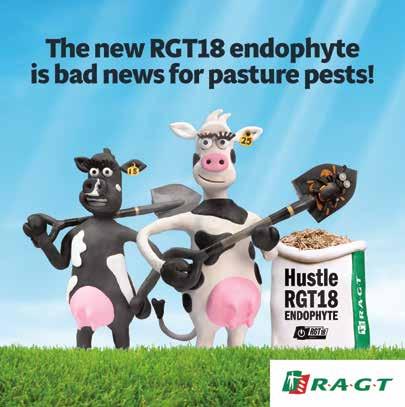
and remain compliant.”
SCADAfarm was recently implemented by Waimakariri Irrigation to provide an irrigation management system for their shareholders.
Chief executive Brent Walton says the decision to go with SCADAfarm was the right one.
“Shareholder engagement with the platform has been great, especially the predictive soil moisture functionality, which has helped our farmers utilise water more effectively and reduce leaching losses. It’s been a win-win all round.”
Other advantages of the system include:
• Predictive soil moisture monitoring. This optional feature helps growers using current and forecasted weather data to predict soil moisture levels up to four days in the future. It is a powerful tool for effective irrigation scheduling.
• Alerts and alarms to warn users of impending limits being exceeded, for example daily volume limits or soil saturation.
• Easy download access to raw data for those for who are ‘data-minded’. A wholeof-season reporting tool is currently under development.
IF YOU OR YOUR CUSTOMERS ARE SICK OF BATTLING POOR CONNECTIVITY, CANTERBURY-BASED CONNECTED FARMS MAY HAVE AN ANSWER.
The company has just launched CommsXtend to help farmers and agribusiness organisations get the best out of their equipment, communicate efficiently and improve the safety of lone workers. It’s a portable on-machine wi-fi hotspot service designed specifically for New Zealand rural conditions.
Able to be integrated with combine harvesters, tractors and service vehicles, CommsXtend amplifies the signal from any mobile operator throughout NZ, even in areas with limited coverage.
“This means farmers and staff can use wi-fi calling and data on their smartphones and agtech devices, and enables the full technical capability of their farm machinery despite patchy cel-
lular networks,” says Connected Farms CEO Tom Andrews, Fairlie.
Many farms have partial coverage by different mobile operators, leading to fragmented connectivity, he points out.
CommsXtend gets around this by offering unified, ubiquitous coverage across the entire farm.
“By dynamically selecting the strongest available signal, it establishes a consistent and robust wi-fi connection.”
This means farmers can operate efficiently and effectively, regardless of the mobile operator’s coverage in different areas of the farm.
"CommsXtend is the cornerstone of improving communications across farms grappling with poor coverage.

“It not only extends connectivity for wi-fi calling in the paddock but also opens doors to remote monitoring, integration of precision technology, robotics and automation, labour-saving measures, and enhanced decisionmaking,” Andrews says. CommsXtend enables agribusinesses to have a fully connected team by providing connectivity and wi-fi on the go, so teams can make phone calls, use data, download manuals, connect service vehicles and utilise tech out on your customer’s land, no matter how remote, he adds.
Luke Robertson, chief technol-
ogy officer for Connected Farms worked with farmers to develop and test the new service.
“Its capabilities extend far beyond conventional connectivity solutions,” he says.
“By fostering a network that enables remote monitoring and seamless integration of precision technology, it empowers farmers with invaluable insights to make real time decisions and take closer control of their operations.”
Connected Farms originated in Australia, where it was also involved in communications deployment for emergency services.

AT A POTENTIAL STARTING COST OF $96,390 A YEAR, LEFT UNADDRESSED, DRENCH RESISTANCE COULD ULTIMATELY THREATEN THE FUTURE VIABILITY OF ONE FAMILY’S HILL COUNTRY SHEEP AND BEEF OPERATION.
This figure was calculated by BakerAg farm consultant Ed Harrison using a Wairarapa family’s 1890 ha farming business as a case study for Farmax financial modelling.
From a baseline total gross margin of $1,186,920, Harrison calculated drench resistance at the lower end, namely drench efficacy of 70-90 per cent, could cost the business $96,390 annually. If drench efficacy were to fall below 70 per cent, financial losses increase exponentially.
The case study family is typical of many sheep and beef farmers who are working to prevent drench resistance becoming a production-limiting issue.
They are part of the Wairarapabased Beef + Lamb New Zealand livestock parasite management group, made up of 12 farms, who are all looking at ways to protect their business from a potential drench resistance challenge.
Harrison modelled five system change scenarios the case study farm could consider as
they worked to reduce drench reliance while still maintaining profitability.
Options were reducing ewe numbers; running a store lamb policy; selling in-lamb ewes; increasing their cattle ratio and only using terminal sires (buying in two-tooth replacements).
These scenarios could potentially be used in combination.
Harrison says it is important that any changes made to a farm system are able to be practically implemented, suit the farm team and don't have any unintended consequences, like increased GHG emissions for example. Drench resistance can have a massive impact on farm efficiency.
Reduced lamb growth means lambs stay on the farm longer, more drench is used and more feed is needed leading to higher costs, further escalation of the existing drench resistance problem and animal welfare issues.
Even in a low to moderate drench resistance scenario, Har-

rison says, average lamb growth rates drop from 110 to 60 grams per day and ewes lose condition as feed is partitioned into slow-growing lambs.
Scanning percentages fall, lactation drops along with pre-weaning lamb growth rates and lambs are retained for longer to achieve saleable weights. What’s the cost?
From a base total gross margin of $1,186,920, Harrison calculated variances for the five different scenarios.

Reducing ewe numbers by 1000 generated an additional $71,820. A store lamb policy would cost the business $39,690, and selling scanned in-lamb ewes would reduce the total gross margin by $15,120.
Increasing the cattle ratio by 6 per cent would add $77,490 to the bottom line and a terminal sire policy would, in theory, add $66,150 to the total gross margin.
Fewer ewes
Fewer ewes would make more feed available, so ewes would be heavier and more resilient to internal parasites.
Increased mating weights would improve scanning percentages, and if that condition was maintained through winter on the extra feed available, they would produce more milk which would drive lamb survivability and pre-weaning growth rates.
Heavier lambs at weaning allow more lambs to be drafted straight off mum. Cull ewe weights would also higher.
In this scenario, extra feed could be partitioned into ewe lambs, allowing hoggets to be mated. Harrison admits that it does require both a change of mindset and confidence to reduce ewe numbers.
This scenario relies on drafting more lambs off their mums at weaning.
More cattle
To maintain pasture quality, running more cattle would complement having fewer ewes.
Cow numbers would increase from 400 to 500 (including heifers) with a significant (1050) drop in ewe numbers.
This would see ewe performance improve due to more feed being available, with the same flock benefits as running fewer ewes.
Terminal policy
Using terminal sires over the entire ewe flock would increase weaning weights by two to three kg, so more lambs could be sold at weaning.
This would reduce pasture contamination by parasites.
Fewer lambs would also mean the ewes would be better fed over summer which would increase scanning and lambing percentages, and weaning weights.
The challenge here would be sourcing the 2700 two-tooth replacements required every year to maintain ewe numbers at 9700.
It is therefore the least practical of the five options modelled.
The critical factor in all these scenarios was weaning weights, Harrison says.
Increasing weaning weights and the number of lambs sold at the weaning draft provides options.
“On a farm with drench resistance, however you get the best weaning weights is the way to go. This means less lamb days on-farm therefore less contamination of pasture with resistant parasites,” Harrison says.
No, we didn’t think so. Predator control on farms can keep rat poo off the menu

Buildings, sheds and food storage areas can attract large numbers of rodents, so ongoing effort is required to reduce trap or bait shyness. Our toolbox will guide you through how to manage pests across your buildings and storage areas.
FENCING CONTRACTORS ASSOCIATION OF NEW ZEALAND (FCANZ) LAST MONTH GAVE AWAY
100 FARM GATE AND GUDGEON SETS AND 10,000 INSULATORS TO TWENTY FARMERS IN THE EAST COAST AND HAWKE’S BAY STILL DEALING WITH THE AFTER-EFFECTS OF CYCLONE GABRIELLE.
The Great Gate Giveaway is the culmination of fundraising efforts in the 12 months since the cyclone and has been made possible thanks to the support of association partners Gallagher, Beattie Insulators and Summit Steel and Wire.
The equipment retails for more than $35,000 and was distributed at the East Coast Farming Expo held in Wairoa on 21-22 February.
“We are a year on from the cyclone, and some of these farmers are still unable to contain their stock. You can’t farm like that. As an association, we hope this giveaway will help ease some of the financial and mental strain that these farmers are feeling,” says FCANZ president Phil Cornelius.
Recipients have been nominated by FCANZ members who work in the area and the local Rural Support Trust co-ordinator to ensure the gates and insulators
make it to those who are really struggling to get on top of their farm fencing.
Family-owned NZ manufacturers Beattie Insulators have donated 10,000 insulators to the cause.
“We are delighted to be able to work with FCANZ to help these farmers. We know it’s only a small part, but every bit helps,” says Ivan Beattie, one of the second-generation company owners.
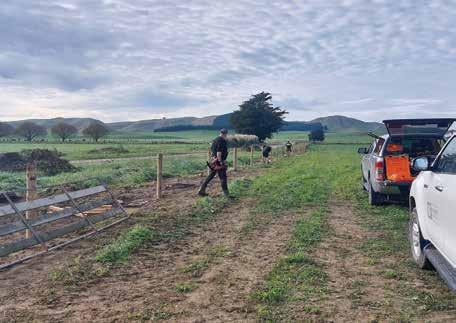
The association also hosted a BBQ during the East Coast Farming Expo for FCANZ members, gate recipients and their families.
FCANZ Patron Craig ‘Wiggy’ Wiggins, and creator of the ‘Lean on a Gate, Talk to a Mate’ movement, was available to talk with people about their concerns for themselves or their friends.
“Some of these farmers are doing it really tough, so it’s never
been more important for people to reach out to their mates and check they are ok. It can be hard to start the conversation, but Lean on a Gate has resources and people to help, no matter what you’re dealing with,” says Wiggins says.
The association plans to be back in the district in early autumn to deliver another two-day refencing event, during which time fencers will volunteer their time to reinstate essential fencing.
Originally planned for late 2023, the event has been delayed to allow the ground to dry out – a plan hampered by recurring rain events.
“The reality is that the scale of damage in the area means it will be some time before permanent fencing work can be started in many areas,” says Phil Cornelius. “It makes sense that we come back in autumn and assist with the reinstatement of essential fencing then.”
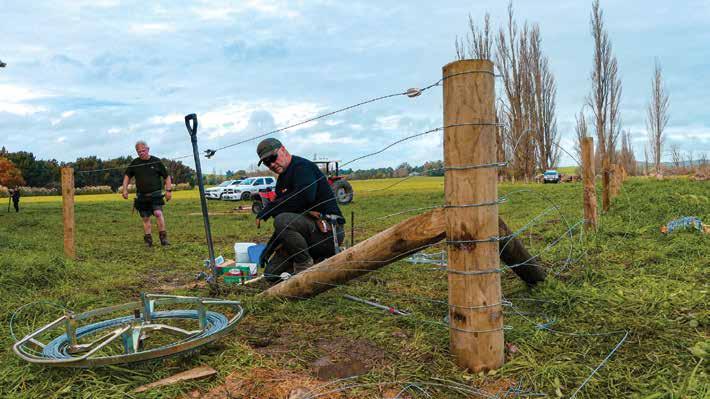
HAZCHEM STORAGE
OUTDOOR CHEMICAL STORAGE

HAZCHEM PPE
CLEANAIR CHEMICAL 2F PAPR PLUS HEADTOP



STS SYNC09 BREATH RESPONSIVE PAPR
• Voice amplifier and speech diaphragm allows clear and safe communication
• Compact and lightweight (745g)
• Long operating times - up to 11.5 hours
• LED filter change indicator
• Visor is anti-scratch coated (outside) and anti-fog coated (inside)
HAZCHEM RESPONSE
CHEMICAL SPILL RESPONSE KITS

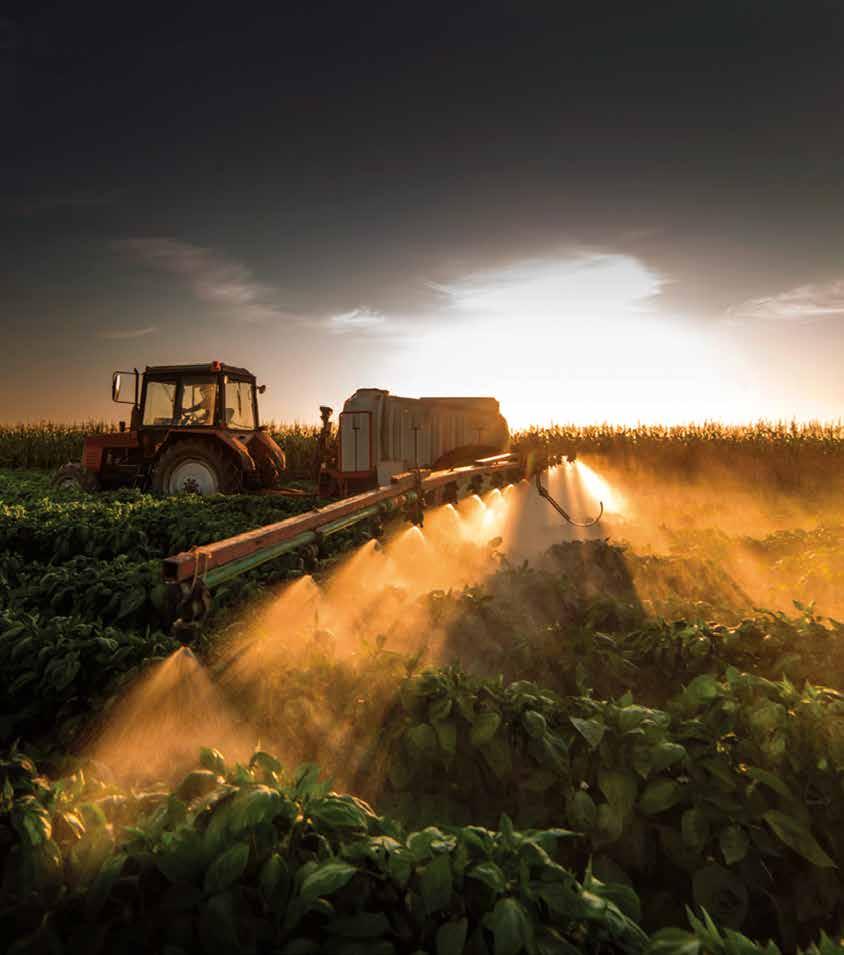
Offering a comprehensive selection of HAZCHEM safety solutions to meet all your farming requirements. Whether you need secondary containment solutions, personal protective equipment (PPE), signage or emergency response kits, we’ve got you covered. Products are available through leading rural supplies retailers.
HAZCHEM SIGNAGE SITE WARNING INFORMATION




Horowai Brown has honed his expertise as one of the managers of the new bagging unit�
A SPANISH ROBOT CALLED AURORA HAS GIVEN SEALESWINSLOW ONE OF THE FASTEST FEED BAGGING PLANTS IN NEW ZEALAND, LIFTING CAPACITY BY 30 PER CENT AND ELIMINATING A LOT OF HARD MANUAL LABOUR FOR ITS TEAM.
SealesWinslow commissioned the machine for its Morrinsville site to improve job satisfaction and ease the effects of the national labour shortage.
National operations manager
Tyler Stuthridge says, like many businesses in the primary industry, SealesWinslow was affected by a shortage of staff post-COVID, particularly for more manual roles like bagging stockfeed.
“It was a real challenge to find staff and turnover is naturally higher in these types of roles.
Bagging can be a very manual job and can involve long hours. It can also take a fair amount of training
and time to do it well. We had to start thinking outside the box.”
Their search led them to Spain where they found Aurora, whose touch screen controls are so intuitive that very little training is involved to use her.
“The primary industry is moving more and more towards robotics and automation to not only solve the labour force challenges we face, but also become more sustainable and far more efficient,” says Stuthridge.
“Robots like Aurora also mean we can free up staff from manual roles to work in higher value and more rewarding positions, which
is a win for everyone.”
Aurora needs just one person to run her.
Their job is to present the bags in packs of up to 450, and she does the rest.
Her simple design makes cleaning and maintenance between jobs easy. She is also equipped with a dust management system, which makes the process a lot cleaner for both the site, and the SealesWinslow team.
“The packing system sets the bag, fills it, and sews it as it moves through the machine. The bag then gets picked up by a stacking arm and stacked onto
pallets of 50 bags and wrapped. The only input needed is someone adding the bags at the start and the forklift driver at the end taking the pallet away,” Suthridge says.
Auroa was also specially configured to use SealesWinslow’s new recyclable bags, which it has implemented as part of the company’s partnership with Agrecovery.
“That was a big consideration for us in choosing the unit. Sustainability is a priority and Aurora helps us achieve our goals, both from an operational and human resources perspective.”
LIC IS COMBINING ITS DNA PARENTAGE TESTING AND GENOMIC EVALUATION SERVICES INTO ONE CONVENIENT SERVICE TO HELP FARMERS IDENTIFY THEIR HIGHEST GENETIC MERIT ANIMALS TO IMPROVE THEIR HERD.
Available to farmers from June, GeneMark Genomics will replace the co-op’s existing DNA
GeneMark Genomics will be available to farmers from June�
parentage testing and genomic evaluation services.
Every eligible sample for female
animals sent to LIC’s GeneMark lab will receive parent verification and a confirmed genomic evaluation (GEv).
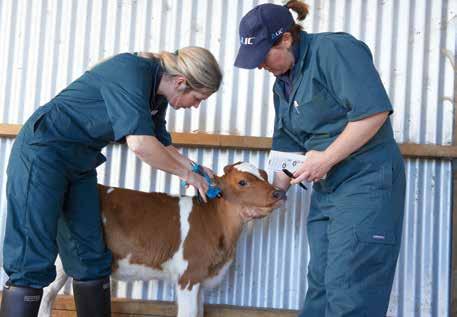
Chief executive David Chin says the new service will offer significant value to dairy farmers and the wider sector, marking an exciting milestone in the co-op’s genomic journey.
“GeneMark Genomics will allow farmers to take the guesswork out of matching calves to their parents, while also confidently selecting the highest genetic merit animals to join their milking herd.
“Rather than relying on parent average alone, genomic
evaluation gives a more reliable indication of an animal’s performance based on which genes it has received from its parents. Combining this service with DNA parentage into one solution is a win-win for farmers.”
Chin says this new solution is very cost-effective and is backed by the co-op’s strong investment in genomics to provide farmers with reliable genomic evaluations.
“Over the past 30 years we have invested more than $80 million into genomics to support the profitability and efficiency of the New Zealand dairy sector well into the future.
“We’re excited to be offering yet another tool for farmers to improve their herds and breed better cows faster.”
For more detail visit www.lic. co.nz.
AN INNOVATIVE AND COLLABORATIVE APPROACH TO FEED PAD DESIGN AND CONSTRUCTION HAS PAID OFF FOR A LOWER WAITAKI PLAINS DAIRY BUSINESS TOTALLING THREE FARMS AND 2500 COWS.
Recognizing the need for change and the impact of weather on their farming practices, Michelle and Rogan Borrie began using the new feed pad on their 500-cow property in winter 2023.
Their other two farms milk 600 and 1100 cows respectively.
“Obviously things move forward and for environmental reasons we decided to put a feed pad on this 500-cow dairy farm,” Michelle Borrie notes, emphasizing their commitment to both animal welfare and environmental sustainability.
Their decision was precipitated by challenging winters characterized by heavy rainfall that turned the farm into a muddy mess, causing difficulty in managing cows and pasture.
In pursuit of a more effective and efficient system, the couple toured several farms to study existing feed pad designs.
From their explorative tours, the Borries identified features they liked and aspects they wished to avoid in their own design.
“We saw ones we liked, but a lot of them had woodchips where we think woodchips are getting harder to get and dearer,” Rogan Borrie says, explaining their decision to opt for a rubber matting option instead.
The rubber matting had a higher upfront cost but promised longevity and cost-effectiveness in the long run.
Their project was taken on by the construction division of NumatAGRI, based in Oamaru.
“After talking to them, they were very keen to come on board and were very enthusiastic and wanted to come and build it for us. So, we thought, well, why not? And we’re very happy with the results,” the Borries say.
NumatAGRI’s willingness to participate and dedication to the project was a driving force behind the successful implementation of the feed pad.
The newly constructed feed pad has been a game-changer.
Cows are fed 3 to 4 kilograms of maize and grass silage on the feed pad and then guided to the milking shed.
Rogan Borrie says they opted for simplicity in the design to avoid potential breakdowns.
“There’s a scraper for the tractor and motorbike and a wheel pusher to push the silage in.
The sharemilker’s got a silage wagon to feed
the silage out. So, there are no mixer wagons. There’s nothing really to break down,” he explains.
They plan to keep the cows on the feed pad 24/7 during winter, feeding them maize and grass silage.
Michelle Borrie says a smooth working relationship with NumatAGRI meant the project was executed seamlessly with no unexpected hurdles.
“I’ve worked with a lot of building agencies and stuff with lots of things happening onfarm constantly. With Numat, this was just very smooth.”
As well as specialising in dairy rubber matting for a wide range of applications, NumatAGRI undertakes full design and construction for feed pads, compost barns, loose-housed barns and free-stall barns.
“With our state-of-the-art drone technology, we can now provide a custom 3D concept design showing how an off-pasture facility could work seamlessly on a farmer’s land,” the company says.
For more detail visit numatagri.co.nz.
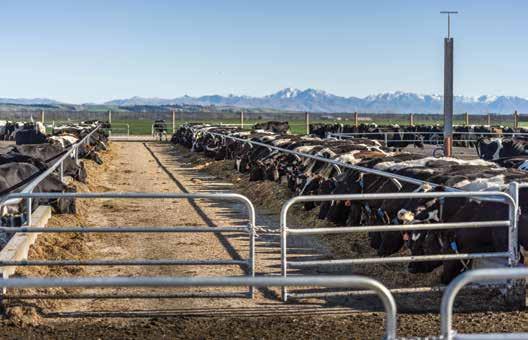
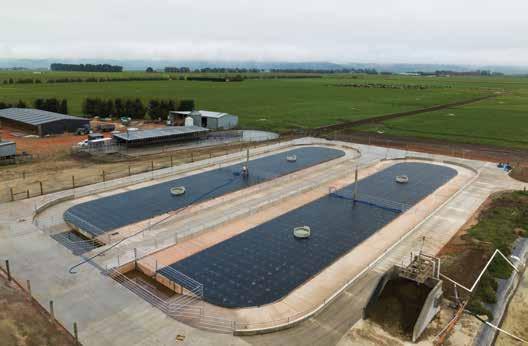
AGRI-MONITORING SPECIALIST HALO HAS SET THE STAGE FOR FURTHER GROWTH BY ACQUIRING VAT-MAN MILK MONITORING FROM DAIRY TECHNOLOGY SERVICES AND TRANSITIONING FARMER USERS ONTO THE HALO PLATFORM AS OF LAST MONTH.
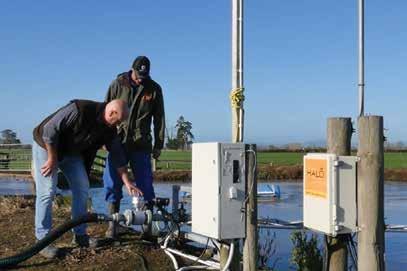
Halo managing director Josh White says it’s a strategic move and significant milestone, solidifying the company’s position as a trusted partner for milk moni-
toring services.
"The team is thrilled about this expansion and the exciting journey that lies ahead for Halo and our new users.
“With the acquisition of VatMan, we're extending our customer base, and providing them with additional monitoring options and opportunities across their farm.
“Innovatively, Halo stands out by providing comprehensive solutions such as water and silo monitoring, as well as effluent management. We look forward to welcoming Vat-Man users to Halo.”
Halo has a long-standing relationship with DTS, which laid the foundation for this transition, White says.
Dairy Technology Services CEO Gavin Thwaites says selling VatMan opens opportunities for both farmer users and DTS itself.
“Halo's expertise in agricultural monitoring will allow Vat-Man users to access additional inte-
grated monitoring solutions.
“The decision to sell the monitoring business is aligned to our strategic direction of focusing on our core DNA of refrigeration services, vats, and drafting gates.
“We have some exciting projects in the pipeline that will not only benefit the dairy industry but also the wider food and drinks sectors.”
Halo’s parent company, Tag IT Technologies, was founded in the Waikato in 2002.
It has since developed cloudbased systems that help farmers and commercial users monitor everything from irrigation, frost protection, effluent, milk and silos to wastewater, pumps and fuel.
For more detail visit halosystems.co.nz.


Words: Animal and Plant Health NZ
A COMMON THEME EMERGING IN AGRICULTURE IS HOW TO BE MORE SUSTAINABLE AND IMPROVE OUR ENVIRONMENTAL FOOTPRINT.
The answer is innovation.
Innovation bridges the gap between meeting global Sustainable Development Goals and increasing yields of healthy and safe food for all.
With nearly 10 billion people to feed by 2050 using less land, water and inputs than ever before, we need to be smarter about how we produce food.
A balance is needed between reducing agriculture’s impact on global emissions and ensuring all people have access to safe and healthy food.
The innovations developed by the crop protection and animal health industries enable farmers to implement the modern, sustainable farming practices required to feed the world. Reducing crop and animal losses is the first step in maximising the land and managing finite resources.
Weeds, insect pests and diseases can destroy a third of a crop before it can be harvested. Pests also render food unpalatable or unsafe for eating during transport and storage. Crop protection products that reduce and, in some cases, eliminate insect damage allow the consumer to purchase high-quality produce free of insect frag-
ments or pest contamination.
Technologies also help increase crop yields and ensure the health of farm animals, allowing farmers to produce more, efficiently, productively and sustainably. They allow efficiency of food production processes, avoiding the need to acquire more land for food production.
By reducing crop and animal losses, we’re also maximising scarce resources like water, fertiliser and energy.
Innovations such as those which minimise the release of nitrious oxide into the atmosphere from crops and animals are another way that the sector is contributing to the sustainability of agriculture.
These are either applied as coatings on fertiliser or on animal feed. Animal vaccinations have also been developed as another way of minimising nitrogen loss.
We therefore rely on crop protetction and animal health products to ensure that farmers and growers can produce enough food for New Zealanders and many people overseas who enjoy eating our excellent dairy products, blemish-free fruit and vegetables, and quality grass-fed meat.
By minimising losses, these technologies
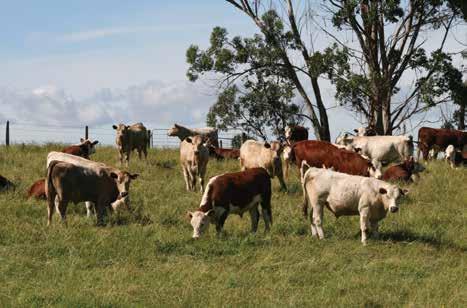
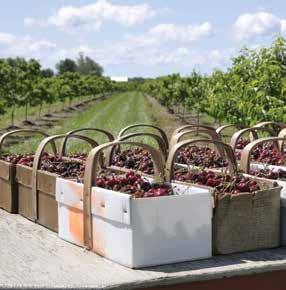
also impact the cost of food.
Helping to keep food prices in check for the consumer is another large benefit of these technologies, which allow people to consume high-quality produce that is free of insect contamination.
As a necessary component of modern agriculture, continued access to safe crop protection and animal healh products is important for the viability of our farmers and our growers. Without them, New Zealanders would be exposed to the very real risk of significant crop loss and economic harm.
But more needs to be done in NZ for farmers to adopt the technologies that are available to farmers offshore.
Farmers and growers are concerned about the lack of effective tools to manage growing pest and disease burdens, especially in horticulture.
This has left them grappling with the dilemma of how to handle potential biosecurity incursions and elevated pest or disease burdens without losing their crops.
Animal and Plant Health NZ is working with the government to address this and arm growers with softer, more targeted and environmentally-friendly solutions to managing pests and weeds, many of which are already available in other parts of the world.
A science-based approach to farming practice and policy will become even more important over the next generation and those to come.
Animal and Plant Health NZ is the industry association for companies that manufacture and distribute crop protection and animal health products.
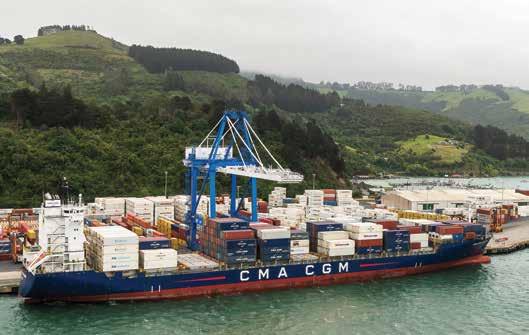
PORT OTAGO HAS WELCOMED BACK THE WORLD’S THIRD-LARGEST SHIPPING SERVICE, CMA CGM, AFTER A FOUR-YEAR HIATUS TRIGGERED BY COVID-19 INTERRUPTIONS AND THE RESULTING SUPPLY CHAIN DISRUPTIONS.
In Australasia, CMA CGM operates as ANL –a shipping line originally established by the Australian Government in the 1950s and purchased by France-based CMA CGM Group in 1998.
Port Otago commercial manager Craig Usher says the return of ANL is great news, especially with peak season approaching.
“It’s particularly good for our customers because it’s a reliable weekly service, and because it links in with four other CMA CGM services that carry product to our exporters’ key global destinations.
“ANL’s reputation for providing a quality service is well recognised. It’s excellent to have them back in the mix.”
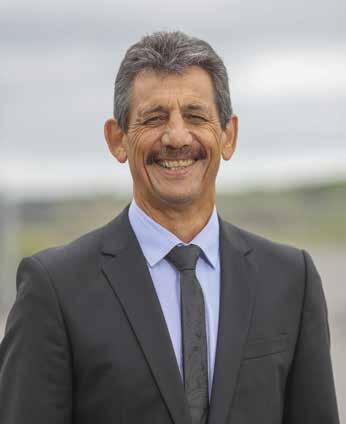
The first vessel servicing the new ANL TRANZTAS weekly service is the CMA CGM Semarang.
The TRANZTAS service has operated in New Zealand for several years.
For the past 15 months, it has called to Sydney – Melbourne – Auckland – Tauranga –Lyttelton.
Last month saw it double the number of calls to: Sydney – Melbourne – Auckland –Port Chalmers – Lyttelton – Nelson – Napier – Tauranga.
From a port business perspective, the ANL service operates to a Wednesday afternoon shipping window.
“Our other three core shipping services operate to Friday to Tuesday windows, so this mid-week window is helpful for optimising our infrastructure and smoothing out our team’s workload,” Usher says.
CMA CGM group agencies general manager Gary Carter says the new rotation marks a positive development in the group’s commitment to the lower South Island.
“ANL serves as a key link to global destinations for exporters and importers. With a reliable major carrier, global market access, new-build reefers and a dedicated Oceaniabased team, ANL stands out by understanding and supporting the complex needs of the Oceania market.
“The timing is crucial to leverage CMA CGM’s capabilities, and the acquisition of a fourth ship expedited the introduction of this enhanced service.”
THREE FOUNDING DIRECTORS OF MIRAKA HAVE STEPPED DOWN AFTER 12 YEARS OF DEDICATED SERVICE, THE COMPANY SAYS.
Kingi Smiler, Maxwell Parkin and Mai Kieu Lien had served the maximum term under the company’s constitution.
Smiler was the company’s founding chairman and the driving force behind the establishment of Miraka, as chairman of cornerstone shareholder Wairarapa Moana.
Under Kingi’s leadership and with the support of his fellow board members, Miraka was established in 2010, and has grown to become a global player exporting products to more than 25 countries.
Miraka is also the first dairy processor in the world to be powered by renewable geothermal
energy, making it a low-carbon leader globally.
“Miraka is proud to be one of New Zealand’s largest Maori export businesses, with exports of $300 million. The founding directors will be remembered as instrumental in the success and growth of the company,” says Karl Gradon, chief executive.
“Looking ahead to the future, we’re also delighted to welcome our new leaders to the board.
They are Te Horipo Karaitiana and Truc Le Quang Thanh who are the appointees of Wairarapa Moana and Vinamilk of Vietnam respectively. Nigel Atherfold was also appointed an independent director.”
HEADWATERS IS A PROGRAM BUILT AROUND BREEDING EWES WITH HIGH FERTILITY, RESILIENCE AND ELEVATED LEVELS OF INTRAMUSCULAR FAT, THAT THEN PRODUCE LAMB SO SUCCULENT ONLY THE FINEST RESTAURANTS IN THE WORLD SERVE IT.
Through Headwaters’ joint venture with Alliance Group, it has crafted its own brand of lamb, Lumina lamb, returning significant financial premiums over standard New Zealand lamb.
Revered for its fine intramuscular marbling, high levels of Omega-3, delicate taste, texture and guaranteed consistency, Lumina lamb has a global reputation as the pinnacle of taste. The Headwaters breed and Lumina lamb therefore continue to act as catalysts between some of New Zealand’s most progressive farmers and the world of fine dining.
Headwaters has a strong established farmer base throughout NZ, and now has over 315,000 breeding ewes.
The commitment to a common goal, of raising hardy animals, with efficient on farm practices and systems while producing a premium product means that together Headwaters farmers are all united in purpose.
A unique part of its commu-
nity is the integrated value chain and the insight and connection gained from gate to plate with full transparency of the product and its success in market.
Headwaters has a contractable system, right from the ram sale to the lamb being processed, every stage being measured to ensure quality is reached and delivered in every aspect. This system also ensures all participants within the value chain benefit.
Research and development have been at the forefront of the Headwaters breed, a genetic make-up that has consisted of endless objective research, analysis, testing and development over the years.
Comprehensive progeny testing is conducted throughout the program and is used to determine the selection for the breeding program and the elite flock.
The Lumina brand has gone on to craft a storyline of the process, with each role within the


process receiving a label.
The Headwaters farmer is the ‘Match Maker’, ‘The Shepherd’, and ‘The Grower’, alongside that is ‘The Butcher’ and ‘The Chef’. Headwaters farmers are committed to breeding healthier, more resilient and productive animals.
Not only do these animals have proven consumer benefits in taste and health-giving qualities, but vividly reflect the increased demand for proven animal wellbeing and meat quality. Headwaters’ purpose is to create and unlock opportunities for future generation sheep and beef farmers.
Genetics are the foundation and a strong part of the program, but combined and integrated with exceptional management and the growing of specific forages is imperative too.
This is where ‘The Grower’ finishes the Lumina lamb on Lumina forage mix (chicory and red clover) for a minimum of 35 days.
A nutrient rich diet that accelerates not only daily growth rates but infuses them with Lumina’s signature mild taste, intramus-
cular fat, marbling and rich polyunsaturated fats.
All lambs are EID tagged to ensure traceability through the supply chain.
‘The Butcher’ is then introduced. Headwaters is partnered with Alliance Group, and this is where all processing is completed.
Being a part of Headwaters is unique in that there is a fully connected value chain.
From farmer, to processing, sales and marketing, and on to chefs and their diners. This gives its farmers a close connection and direct insights to every stage.
Lastly, ‘The Chef’. With the consistency of Lumina Lamb, chefs enjoy working with it in the kitchen.
The micro marbling means the meat doesn’t behave like regular lamb, it’s more versatile. It gives the chef more options and room to leave their mark on a dish.
Headwaters farmers and Lumina finishers communicate directly with the chefs.
For more details contact Andrew Bendall, 027 299 5597.
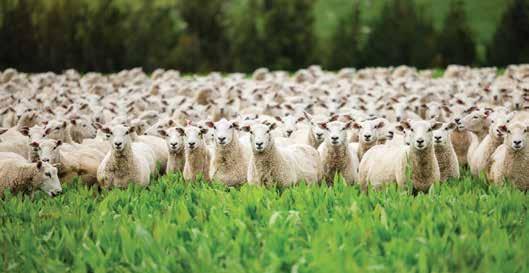
GLOBAL PET FOOD BRANDS STARVED OF OPPORTUNITIES TO MANUFACTURE IN NEW ZEALAND WILL SOON HAVE ACCESS TO A NEW STATE-OF-THE-ART CANNING FACILITY.
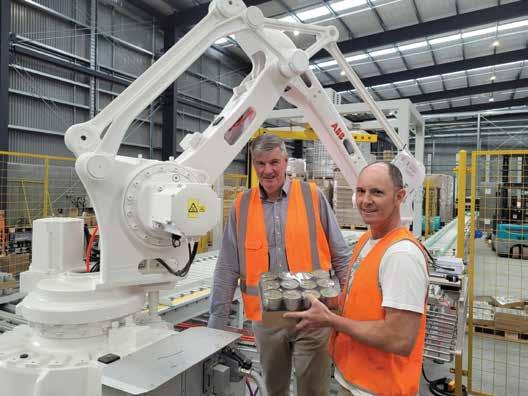
Built by an experienced team of pet food entrepreneurs, the ultra-modern Christchurch factory will each year make 30 million cans of high-value cat and dog food, adding significantly to an industry generating over $NZ300 million in exports annually.
Set to open this month, the plant established by Riverland Foods is a first for NZ.
It will produce exclusively for their clients’ brands, removing a logjam that limited NZ as a go-to destination for third-party manufacturing.
NZ is known for its high-class ingredients and strong country brand and reputation, leaving pet food companies frustrated they couldn’t make product here.
General manager Michael Dance
and colleagues, all veterans of the pet food industry, spied the manufacturing gap in NZ, so in 2022 began developing plans for the Hornby facility.
“With global sales of cat and dog food at $US58 billion ($NZ95 billion) predicted to more than double by 2030, there is huge demand for access to modern manufacturing facilities which
are both adaptable and innovative,” Dance adds.
“Initial investment in the project exceeds $NZ30 million but further funds are committed for future staged development.”
Alongside Dance, the team driving Riverland includes head of operations Tom Coughlan, quality assurance officer Sarah Morris, and site manager Chris Gourlie.
Coughlan, Dance and Gourlie are all former managers of NZ pet food company Ziwi.
Coughlan, who ran a meat processing business before switching to pet nutrition, is looking forward to providing high-quality cat and dog food made from the best ingredients in the South Island.
“We chose Christchurch because of its proximity to processing plants and quality raw materials,” Coughlan says, adding that mainly rural Canterbury is a strategic location for New Zealand’s top meat processors.
Dance says that over 95 per cent of the plant’s output will be sent overseas, boosting value-added exports and aligning with the coalition government’s aim for NZ to become an ‘export powerhouse’ by focusing on an economy that enables wealth creation and maximises added value before exporting.
Building the new plant in Christchurch gives ready access to meat processors and quality raw materials�

‘OUTSTANDING’ SKELLERUP CEO DAVID MAIR WILL STEP DOWN AT THE END OF THIS MONTH.
Mair joined the Skellerup board in November 2006, and was appointed as acting CEO in July 2010 before taking on the CEO role on a permanent basis in July 2011.
He will continue to serve as a director of Skellerup and along with Paul Shearer will lead a special project initiative with management to progress inmarket capabilities.
Chairman John Strowger paid tribute to Mair’s performance last month.
“David has been an outstanding CEO. Over the almost 14-year period he has been in the role, Skellerup’s annual earnings have grown by more than 400 per cent.
“Shareholders have been well rewarded by David’s expertise, leadership and relentless drive for growth and improvement.
“His success has rightly been recognised over recent years,
and whilst I have previously remarked that our growth and performance are through the contribution of many, they have been expertly enabled and led by David.”
With Mair remaining as a director, Skellerup and its shareholders will continue to benefit from his skills and knowledge, Strowger says.
Graham Leaming has been appointed as CEO to replace Mair.
He joined Skellerup as CFO in December 2012, and will be succeed in that role by Tim Runnalls, who joined Skellerup as group financial controller in March 2021.
Strowger says Leaming is a proven performer, having led a range of commercial functions delivering great value for Skellerup over the past 11 years.
“Together David and Graham have been a formidable team. We are very confident that Gra-
Petfood manufacturing has been identified by consecutive governments’ reports as a high emerging growth industry within the food and beverage sector.
Commissioned by MBIE, the 2021 Coriolis report concluded NZ’s pet industry had low production costs, high productivity people and farming systems, and was located close to growth markets in Australia and Asia.
“Riverland Foods is leveraging this growth, working alongside pet food technicians to create new recipes and textures for products while engaging with researchers and nutritionists to ensure all decisions are based on quality data and science,” Dance says.
“A key point of difference is our in-house research and development kitchen for testing product concepts cost-effectively and quickly before scaling up to commercial production. ”
Another Riverland advantage is its ability to quickly adjust recipes as demand changes for cat food, with various cats preferring different textures such as mousse, pate or chunky-

ham will be a strong and successful leader for Skellerup backed by a strong team with a passion and capability to con-
tinue to deliver great products for customers and sustainable earnings growth for shareholders.”
with-gravy styles.
All of these textures have a different ‘mouth feel’ and for cats that’s really critical, Dance says.
“Because cats can whimsically change whether they like a texture or not, a cat will stop eating one texture in preference to another, forcing the pet food company to stock a range of textures - or they lose a customer.
“Riverland’s ability to make many different textures gives brand owners the opportunity to hold on to their customers within their brand.”
While other plants exist, they’re either very small, running at full capacity making their own brands, or in long-term contracts for a small number of large clients, meaning smaller and innovative brands can’t make their pet food in NZ.
“Not producing our own brand gives us a real point of difference. All customers are treated equally. It also provides us with flexibility to meet the changing market demands such as
different product textures and formulations,” Dance says.
Riverland is attending global trade shows, in discussion with brand owners in North America, Asia and Australia to manufacture their products, and is a member of the NZ Pet Food Association.
Pet Food Association executive director Richard Brake says the addition of worldclass production capacity is very welcome.
NZ pet food exports have quadrupled in less than a decade, increasing from $75 million a year in 2014 to $320 million in 2023.
“Retail-ready petfood exports have been growing very strongly for some time. Growth is at 17.4 per cent into North America and 25.3 per cent into Asia,” Brake says.
“A recent plateau in exports was caused by production capacity constraints and most recently the effects of Cyclone Gabrielle on East Coast manufacturers, but the addition of Riverland’s factory will further boost NZ pet food exports.”
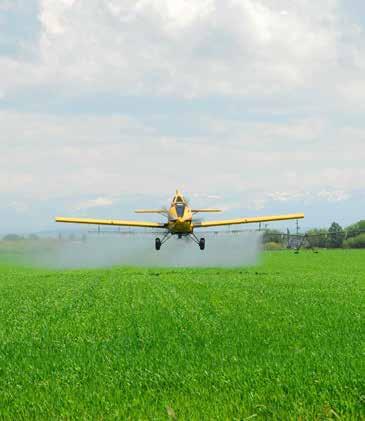

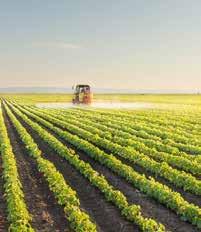
Aerial and ground spray applicators can help protect bees:
Avoid spraying in windy conditions to prevent drift. Take into account wind direction and atmospheric stability.
1 2 3 4 5 6 7 8
Implement an integrated pest management plan to apply pesticides only when necessary.
Coordinate with local beekeepers before spraying so nearby hives can be moved or otherwise protected.
Follow the instructions on the label to ensure you use only the recommended dose.
Use drift-reduction application equipment that is well maintained and calibrated.
Avoid spraying pesticides when bees are foraging
Avoid contamination from spray liquids when mixing and properly dispose of waste and other used materials.
Use genuine products and alert authorities of counterfeit or illegal pesticides as they have unknown impacts on wildlife.
CHELSEA ALABASTER’S HAS RECENTLY BEEN APPOINTED AS EAST COAST SALES AGRONOMIST FOR PGG WRIGHTSON SEEDS.
Providing excellent customer service and adding value to the farm business is what she is most passionate about and something she is excited to bring to her role with PGG Wrightson Seeds.
“I love being posed with a challenging situation and finding out the needs and goals of the client and what will be the best crop solution that fits their farm system within environmental parameters,” she says.
“Farmers face a challenging time at present with the current economic environment along with the demands on them to be more sustainable in the environmental space.
“I believe we have the right products and technical expertise to be able to add value and allow farmers to navigate these challenges. My belief in building strong and long-lasting partnerships with everyone in the supply chain can help.”
Alabaster grew up rurally on a small block and worked in marketing in rural retail after completing her Bachelor of Business Studies. She then had a stint in the Australian out-


back, working on a 400,000-acre cattle property in North Queensland, where not only did she learn the differences between New Zealand and Australian farming but also the finer points of camp drafting, barrel racing and outback rodeo riding.
Upon her return to NZ, she was offered a position in the fast-moving consumer goods (FMCG) sector at the end of the supply chain, working as a marketing co-ordinator for Foodstuffs NZ.
During her time with Foodstuffs, Alabaster navigated many different personalities and departments, an experience which she says has helped her support farmers in the field today.
After a further FMCG sales role, she was keen to get back to agriculture and spent time working for a large rural retail firm as a technical sales representative.
After several years in her technical role, she took a substantial sabbatical from the industry to start a family with her husband, Nick.
The sales agronomy role with PGG Wrightson Seeds was too good to pass up when it presented itself last year, especially with her experience in sales, marketing, and agronomy.
Starting in October 2023 meant she hit the ground running, which was, in hindsight, the best way to get back into the swing of things, ‘as all my knowledge came flooding back’.
PGG Wrightson Seeds was always on her radar as it has a strong history of being a great company to work for, she says.
She had always been impressed with the research and development from PGG Wrightson Seeds and the investment in creating new cultivars and enhancing current cultivars to keep the industry moving forward.
“The amount of time, resources and sheer passion from our team that is put into our company product portfolio is truly astounding, it is an exciting company to be in at present with some phenomenal scope in our portfolio to come in the near future.”
MAX NIGHTINGALE HAS BEEN AWARDED THE NEW ZEALAND SOCIETY OF SOIL SCIENCE’S 2024 POST-GRADUATE BURSARY AWARD.
Sponsored by the Fertiliser Association of NZ, this award recognises the efforts and present or likely contribution to NZ soil science arising from a doctorate study.
Winners receive a $5000 one year stipend. Nightingale was presented his award on World Soil Day by NZ Society of Soil Science president Sam Carrick.
Currently in his third year of research in environmental science at Canterbury University, Nightingale’s work addresses the application of winery wastewater to land, and the impli-
cations of this for soil quality and carbon sequestration.
During his Ph.D. programme, he has sought to determine the likely effects, both in the short and long term, of irrigating winery wastewater to soil at rates at which water and nutrients may be beneficially used by plants. Winery wastewater is an unavoidable, high volume by-product of the winemaking process, generated from grape processing and cleaning operations within each of the wineries.
WITH A BACKGROUND IN MOLECULAR BIOLOGY AND HANDS-ON FARMING EXPERIENCE, PERRIN AG’S NEWEST CONSULTANT SAM GRAY LOVES HELPING FARMERS BOOST PRODUCTIVITY AND NAVIGATE THE EVER-CHANGING REGULATORY ENVIRONMENT.
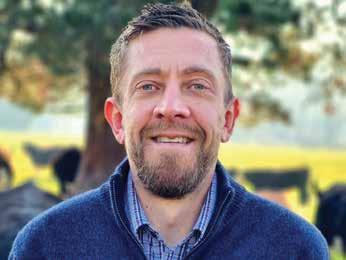
Gray lives in Taupō with his partner Karoline on the 56 ha farm they purchased six years ago after they returned from Scotland. There, he was working as a medical researcher at the University of Edinburgh.
Gray grew up on a dairy farm in the Far North, but after completing a Bachelor of Applied Science in Molecular Biotechnology in 2005 from the University of Ota-
go, he embarked on a path into medical research.
“I initially worked at Auckland University looking at the genetics of bone diseases and then travelled overseas. I was working at the University of Edinburgh researching in the same area, predominantly related to gout, before we returned to New Zealand.
“I found myself looking more
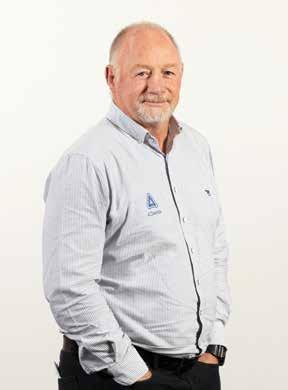
and more out the window from the laboratory and wondering whether I'd enjoy working outdoors in a more practical application of my skills.”
He and his partner, who is a German translator, returned to NZ in 2012 and dairy farmed for four years before purchasing their farm.
Before joining Perrin Ag Gray used to rear 300 beef calves each spring, selling half as weaners at 100 kg and rearing the balance through to 18 months and 600 kg.
“I love farming, but I was searching for more balance. The role at Perrin Ag allowed me to combine my science background with helping farmers.
“In medical research you’re often focused on a very small problem and go into massive detail picking it apart. In farming you can have 100 different problems in a day and you’re solving them as you go. At the end of the day, you can see what you’ve done, and I find that very rewarding.”
At Perrin Ag, Gray has been helping farmers navigate complex and rapidly evolving environmental regulations from nitrogen caps to developing Freshwater Farm Plans.
Alongside working directly with farmers, Sam is also involved in an industry project aimed at measuring the effectiveness of various mitigation strategies in reducing nitrogen loss, a representation of the type of industry research Perrin Ag is also involved in.
“A lot of farmers are feeling overwhelmed and uncertain about compliance. The work we do at Perrin Ag helps bridge the gap. We help farmers translate regulations into practical solutions that enable farmers to remain compliant while excelling at what they do best: farming,” says Sam.
Outside of work, Gray is an outdoors enthusiast enjoying the fly fishing, hunting, and snowboarding he is fortunate to have on his back doorstep.
RECENTLY RETIRED ADAMA NZ BUSINESS MANAGER BLAIR HOPKINS IS LEAVING FEELING VERY CONFIDENT THAT THE BUSINESS AND CLIENTS ARE IN EXCELLENT HANDS.
Hopkins says he’s been excited seeing the new talent coming through at ADAMA. “There are some really great people, ADAMA’s in a very good position.”
He says the time was right for him to hand over to Phillip Dasler – someone he knows well as he has been dealing professionally with him for the past 13 years.
Hopkins’ own rich and varied career began in the timber industry on the West Coast of the South Island, before moving to Dalgety’s and then Wrightson in 1988 as a merchandising manager.
He shifted to Canterbury in the mid 90s, progressed through a variety of roles before
being appointed as district manager, Wairarapa, in 2001.
In 2004 he left Wrightson and moved to Auckland to try his hand at non-agriculture related companies, but his heart was always back in agriculture.
That, he says, gave him an opportunity to get a broader perspective, and look at things differently, while still being focussed on delivering great customer service.
“It provided an added extra depth of experience that was worthwhile.”
The lure of returning to agriculture, ultimately, drew him back to Canterbury and in 2010 he moved back to Christchurch and
IT’S NOT EVERY DAY AN UNDERGRADUATE STUDENT GETS TO LEAD THEIR OWN RESEARCH PROJECT, BUT THAT’S THE REALITY FOR THOSE WHO UNDERTAKE A SUMMER INTERNSHIP WITH CORTEVA AGRISCIENCE.
Funded through the Callaghan Research Grant program, students get to experience Corteva’s Global Research Facility based at Waireka just outside of New Plymouth.
An excellent opportunity for students to gain experience in field research and development, develop new skills and work with dedicated scientists, the Corteva internship program caters for students who are keen to gain hands-on practical experience at a world-class research facility.
Corteva Agriscience ANZ field science leader Brian Husband says the primary purpose of the internship is to give students research and development experience.
“The expectation is that students will be able to see R&D firsthand and be involved in the R&D.
“We give students a project to work on where they can assist with the planning of it, they go out and do the work, and at the end of the season they present their findings to the Waireka team.”
The internship runs for 10 to 12 weeks and is open to any student undertaking study in the agricultural or biological sciences disciplines.
Second-year university student Bree Drinkwater is one of the two students undertaking the Corte-

va internship this summer.
Studying a Bachelor of Science, majoring in biochemistry, through the University of Canterbury, she was looking for work experience that would give her a taste of the different career opportunities available in the science field.
“I wanted to do hands-on work but also wanted to be able to gain experience in research, so was looking for a diverse range of opportunities,” she says.
“I also wanted to see the knowl-
edge I’ve learned in university applied in a practical sense.”
The hands-on work and research experience was also what drew Mitchell Bunning, who is studying a Bachelor of Agriculture at Lincoln University.
“It has turned out to be the perfect summer job,” he says.
Working on early-stage products and trialling whether they fit into the New Zealand and global markets, Brian Husband says the program not only benefits the students, but also plays an
important role in ensuring the facility can get through its large research workload.
“One of the benefits of receiving the Callaghan Research Grant and having the students work within the facility is it allows us to conduct many research projects which we may not otherwise get done,” he says.
“Summer is a very busy time of year and it’s very much a bottleneck for us, so having the students participate in the research is great for all involved.”
started with ADAMA.
And, he says, he’s thoroughly enjoyed the past 13 years, particularly the people he’s worked with. “That’s what it’s all about.”
In every sector he’s worked in, Hopkins says people were the most important thing but, he says, that’s doubly true for agriculture.
“Everyone knows everyone else. It’s all about relationships. And, I’d have to say, in this business, there’re really good people. Many customers have become very good friends!”
During his time in the agricultural industry,
Hopkins has seen some big changes, but the trick is to "not over complicate things and if it’s good for your customer, then it will ultimately be good for you.”
While at ADAMA, the company experienced a period of exponential growth. “It was great to be part of it, and the biggest thing I will miss is the interaction with the team and customers.
“There is a considerable number of people in the industry my age that will be exiting the industry in the next couple years. I just hope that the next group taking the industry for-
ward have as much fun as we have!”
As Hopkins looks forward to retiring, he will be spending more time fishing/diving and tramping from his home base of Motunau.
Between that, his grandchildren, his daughter and son-in laws’ vineyard and apple orchard and community work, he doesn’t imagine he’ll have a great deal of spare time.
“There’s always something to do.”
ADAMA wishes him all the best in retirement and thanks him for all his knowledge and support.
His quick wit and stories will be missed.
“If you’re not farming, it’s the next best thing.”
OVER HIS LONG CAREER, RETIRING ADAMA COMMERCIAL MANAGER, CANTERBURY, DAREN MABEY HAS COVERED A FAIR BIT OF GROUND WITH HIS WORK. “EVERYWHERE FROM NORTHLAND TO CANTERBURY.”
Mabey says his career in the industry has been rewarding. “It’s been a blast. It’s the best industry in the world. If you’re not farming, this is the next best thing.”
While he had a solid farming background (dairy, sheep and beef), as he explains, it was thousands of miles away that his career was actually kickstarted.
“I went on my OE to the UK to see my sister and ended up having a four-year long education on grain and seeds working for the then industry leader.”
That was an experience that made a lasting impression.
On returning to New Zealand Mabey worked for the ‘who’s who’ of the agricultural industry, being shoulder-tapped by companies including Hodder and Tolley, Elders, Nufarm and then Crop Care, Syngenta, and
ADAMA, where he’s worked for the past 13 years.
While he has been a commercial manager for crops ranging from kiwifruit to maize, and apples to grapes, he says cereals have always been a particular favourite – harking back to his initial time in grain and seeds.
Mabey says people and agronomy always came first in his work. “I’ve always loved growing things.”
Laughing, he says if there was one downside to his job it was that he never got called to see a good crop, only the ones that had a problem!
Solving those problems was a matter of knowledge, experience, and good relationships.
“It’s a trust thing. When you recommend a product – whosever product that is – people will know it’s the best product or advice for the job. And, while
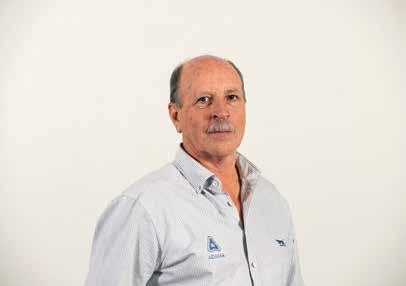
doing that, if I could also help someone look good and be appreciated by their customer, that made it an awesome day.”
Mabey says he’s grateful for the opportunities he’s had to travel and study but most of all for the people he’s worked with.
“People colleagues and customers have just been amazing. And customers are not just ‘customers’, a lot of them are friends.”
He says he’s also valued his colleagues, “You can just jump on the phone and have a yarn. Workmates are pretty special in this game.”
He’s also enjoyed mentoring younger members in the industry.
And he has some advice to pass on.
“One of the best things some-
one told me, earlier in my career, was to not continually try and climb ladders. Excel at what you do, and you’ll get well recognised and rewarded, but don’t forget to look after your family life.”
With nine grandchildren, and a new built home in Methven still requiring landscaping, he is not going to be short of something to do anytime soon.
His retirement will also give him a chance to indulge his wide-ranging hobbies including car club, tramping, hunting, his classic caravan, and enjoying his recently purchased season ski pass.
The team at ADAMA thank Mabey for all the support and knowledge he has shared over the years and wish him all the best in his next adventure.
MINISTER ANDREW HOGGARD SAYS.
“It’s truly heartening to see both the number and calibre of applicants who applied for these scholarships. It is the first time they have been offered.
“The six successful scholarship recipients have a passion for food and fibre production and a genuine interest in joining the primary industries advisory sector.
“The coalition Government wants to ensure we make farming an attractive career option for young people again.
The scholarships are part of the coalition Government’s efforts to boost on-theground support for farmers and growers.
“The coalition Government is committed to improving support and operating conditions
for farmers and growers,” Agriculture Minister Todd McClay says.
“We’re backing a range of initiatives to grow the capacity and capability of the primary industry advisory sector, which is vital to supporting farmers to adapt, change, and thrive.
“As part of that, we have awarded six scholarships, worth a total of $30,000, to students studying agricultural science or environmental science degrees.
“Agriculture is the backbone of our economy, with revenue from food and fibre sector exports forecast to generate $54.3 billion in the year to 30 June 2024.”
Three Massey University students - Ffion
White, Katya de Silva and Nerissa Edwards - and three Lincoln University students - Jed McCready, Kate Sheehy and Laura Heads - have received the $5000 scholarships for the 2024 study year.
Massey and Lincoln universities were chosen for the scholarships because they have well-established agricultural and horticultural science programmes with a longstanding tradition of producing primary sector advisers.
Andrew Hoggard says farmers and growers have had to navigate challenging conditions in recent years and the advisory sector plays an important role in supporting their success.
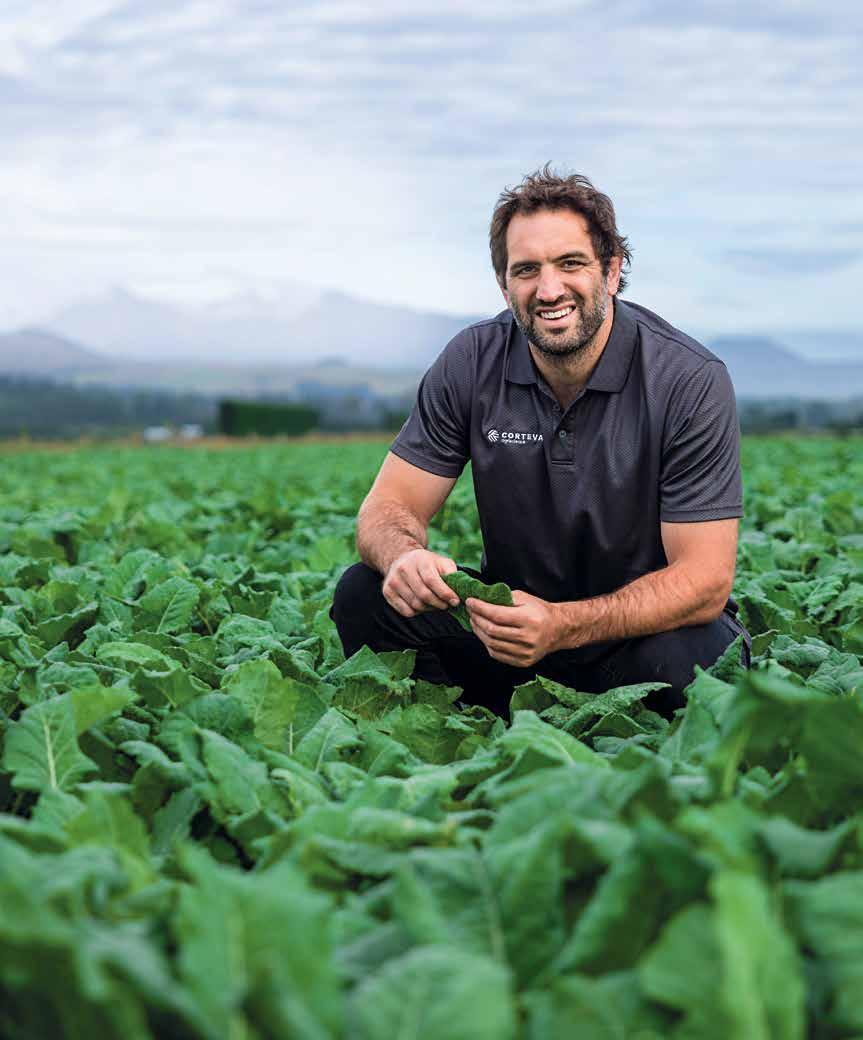
I’ve had some great teammates over the years and my friends at Corteva Agriscience are up there with the best of them.
Their suite of world class products – including Tordon™ Brushkiller XT, Tordon™ PastureBoss™, Korvetto™, Sparta™ and Transform™ - helps farmers achieve truly exceptional results.
Corteva are on a mission to enrich lives for generations to come – and that’s exactly the kind of company I want on my side.
For more information talk to your agricultural merchant or call 0800 803 939 today. Always read the label before use.

All over the country more and more growers and agronomists are turning to the trusted performers and the ever-growing range of crop protection and production solutions from BASF

